Anthropic
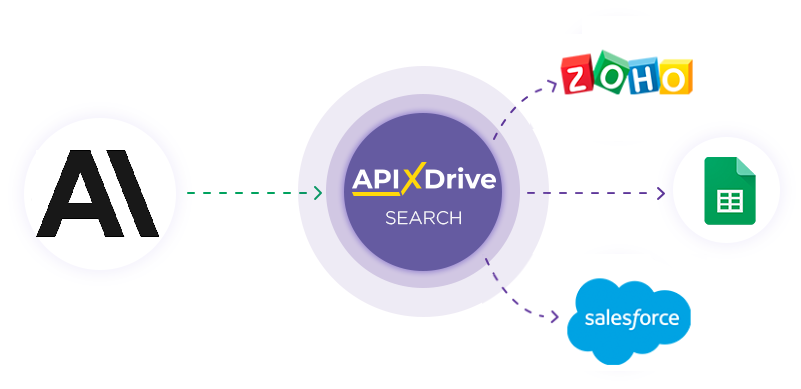
Integration with Anthropic is implemented as a separate AI TOOLS (ChatGPT) block, which can be placed between the Source and Destination of data. This will allow you to create a query based on data from the Data Source and pass data from Anthropic to the Data Ingest fields. This way you can automatically receive data from Anthropic and transfer it to the services and systems that you use.
The function allows you to create a request in Anthropic and send the result of the request to Data Destination.
Navigation:
Connecting Google Sheets as a Data Source:
1. What data can you get from Google Sheets?
2. How to connect your Google Sheets account to ApiX-Drive?
3. Select the table and sheet from which rows will be unloaded.
4. An example of data that will be transferred from Google Sheets.
Connecting Anthropic:
1. What data can be obtained from Anthropic ?
2. How to connect your Anthropic account to ApiX-Drive?
3. How to configure data search in Anthropic in the selected action?
Claude 3.5 Sonnet
Claude 3 Opus
Claude 3 Sonnet
Claude 3 Haiku
4. An example of data that will be transferred from Anthropic .
Setting up row updates in Google Sheets:
1. What will the Google Sheets integration do?
2. How to connect your Google Sheets account to ApiX-Drive?
3. How can I configure the selected action to transfer data to Google Sheets?
4. Example of data that will be sent to your Google Sheets.
5. Auto-update and communication interval.
Setting up Data SOURCE: Google Sheets
Let's look at how the function of requesting data from Anthropic and sending the result to Google Sheets works.
First, you need to create a new connection.
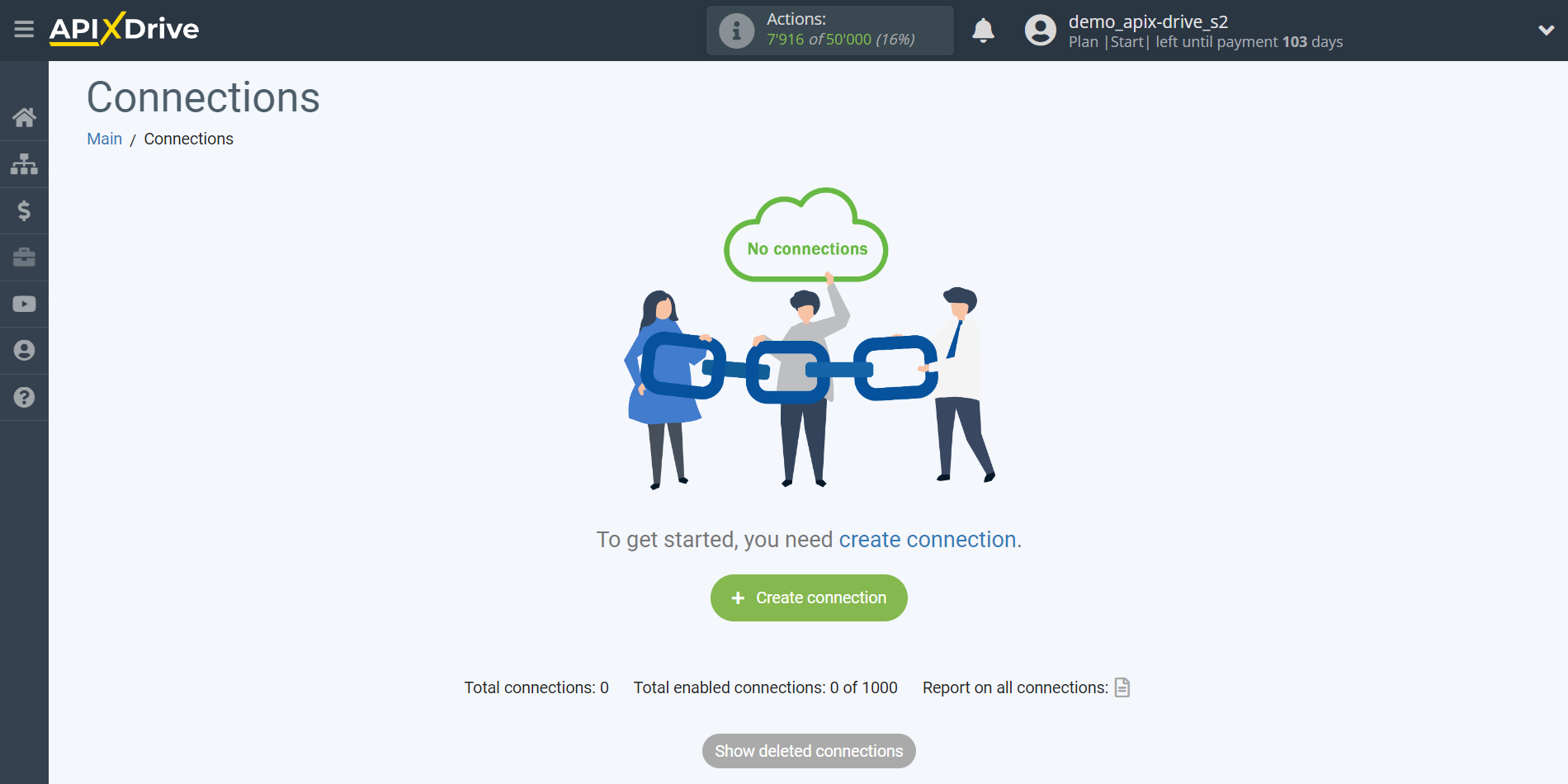
Select the system as the Data Source. In this case, you must specify Google Sheets.

Next, you need to specify the action "Get ROWS (new)".

The next step is to select the Google Sheets account from which the data will be uploaded.
If there are no logins connected to the system, click "Connect account".
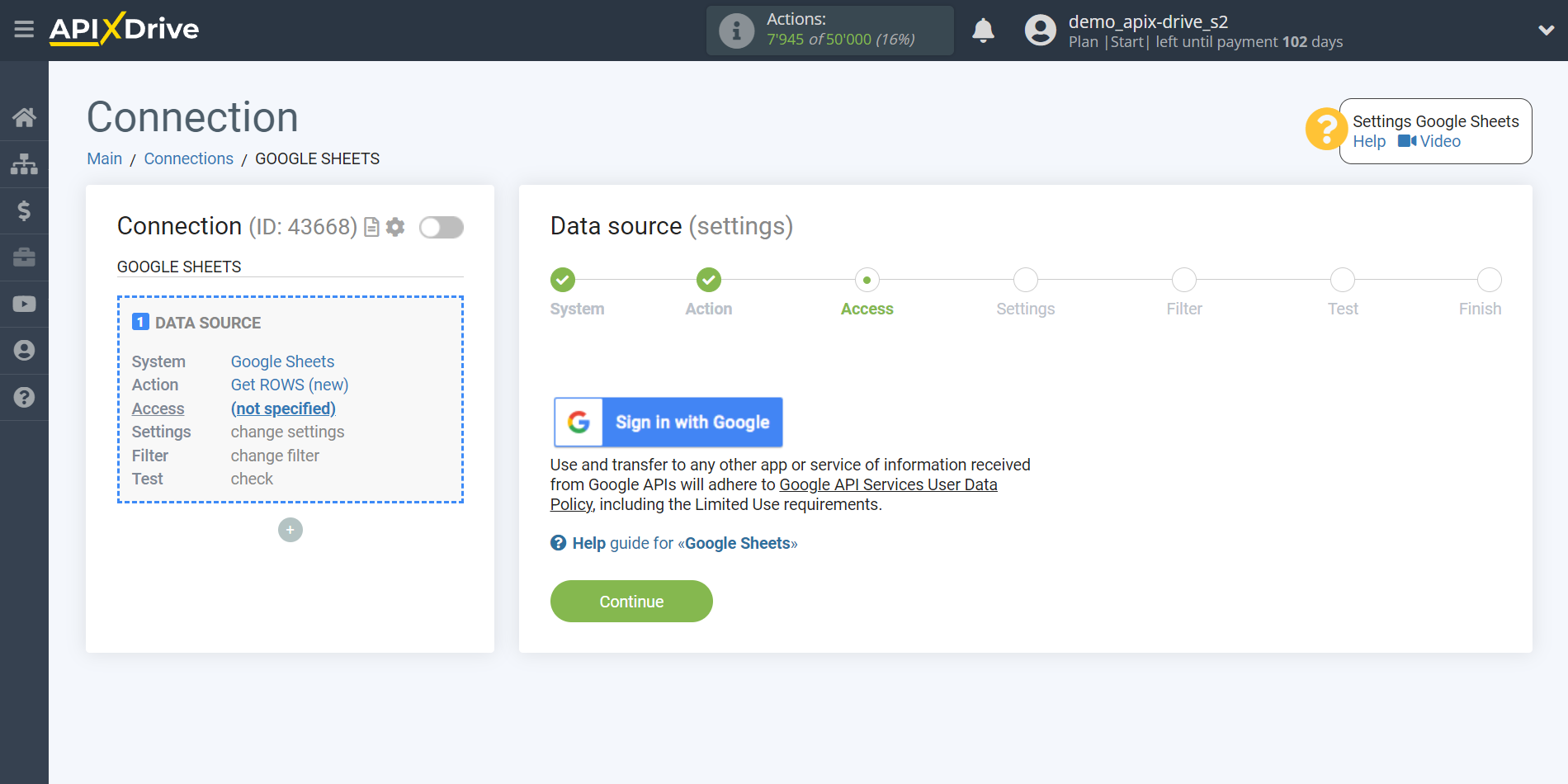
Select which account you want to connect to ApiX-Drive and provide all permissions to work with this account.
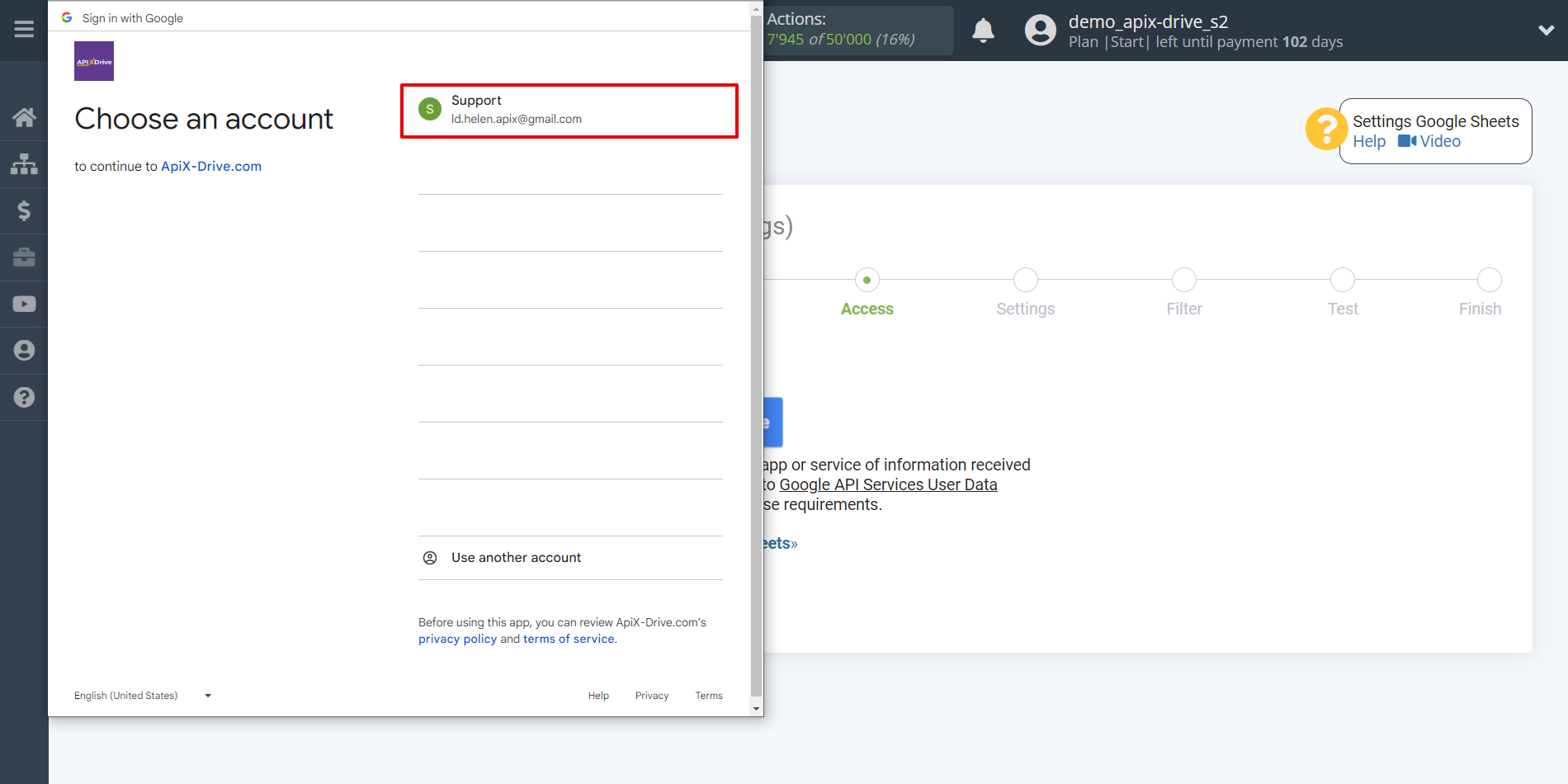

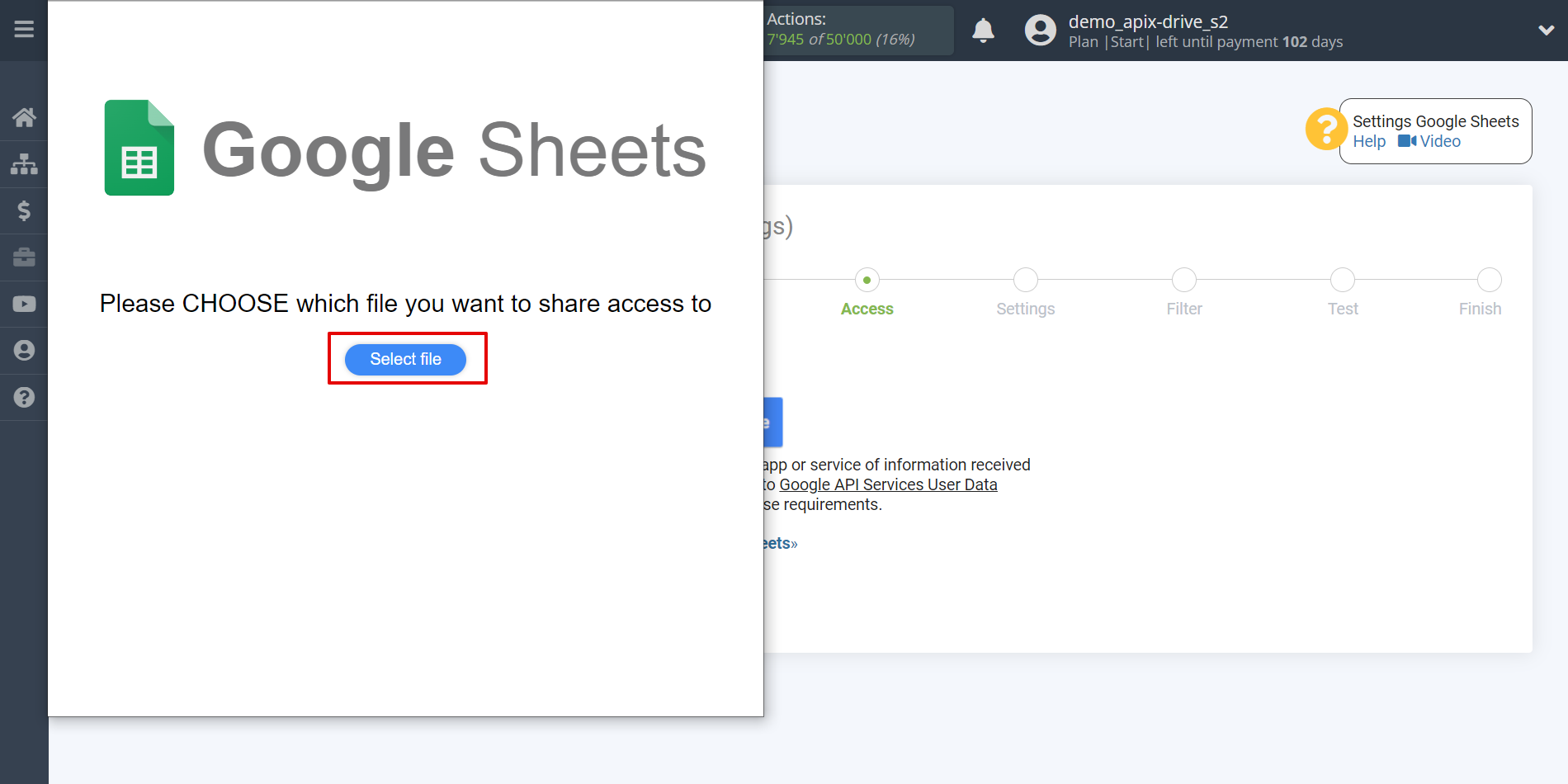
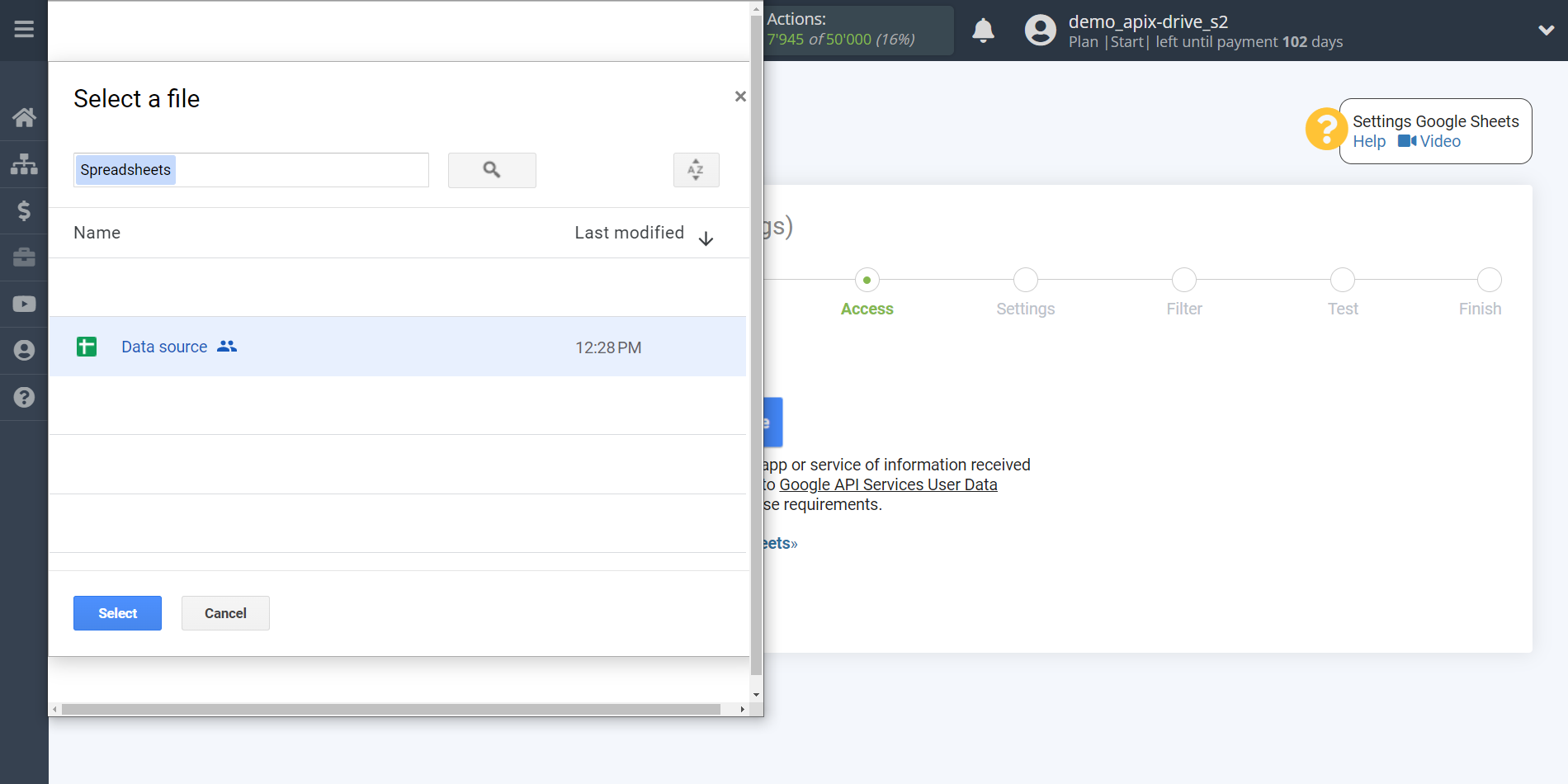
When the connected account appears in the "active accounts" list, select it for further work.
Attention! If your account is on the "inactive accounts" list, check your access to this login!
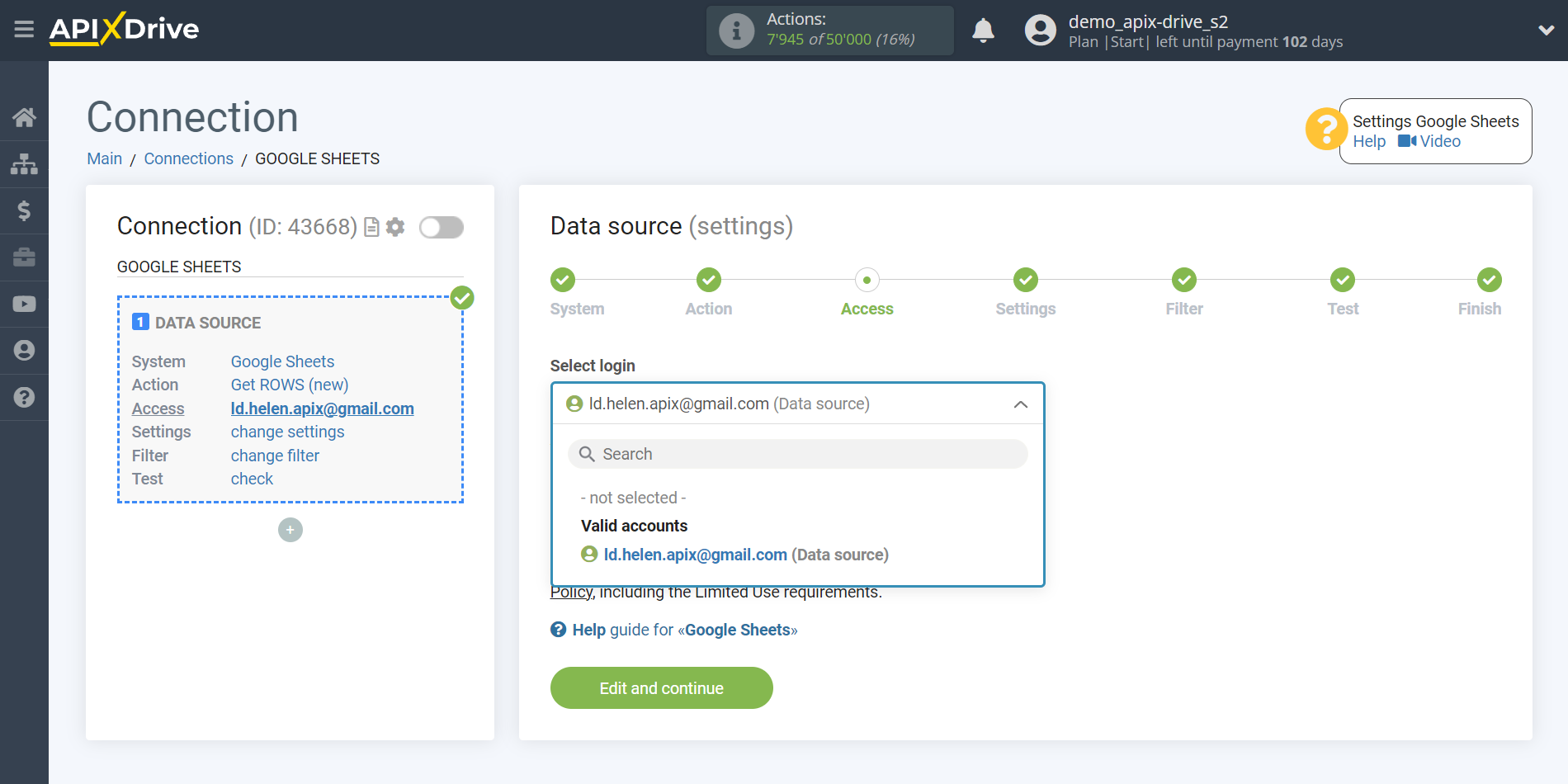
Select the Google Sheets table and sheet where the data you need is located.
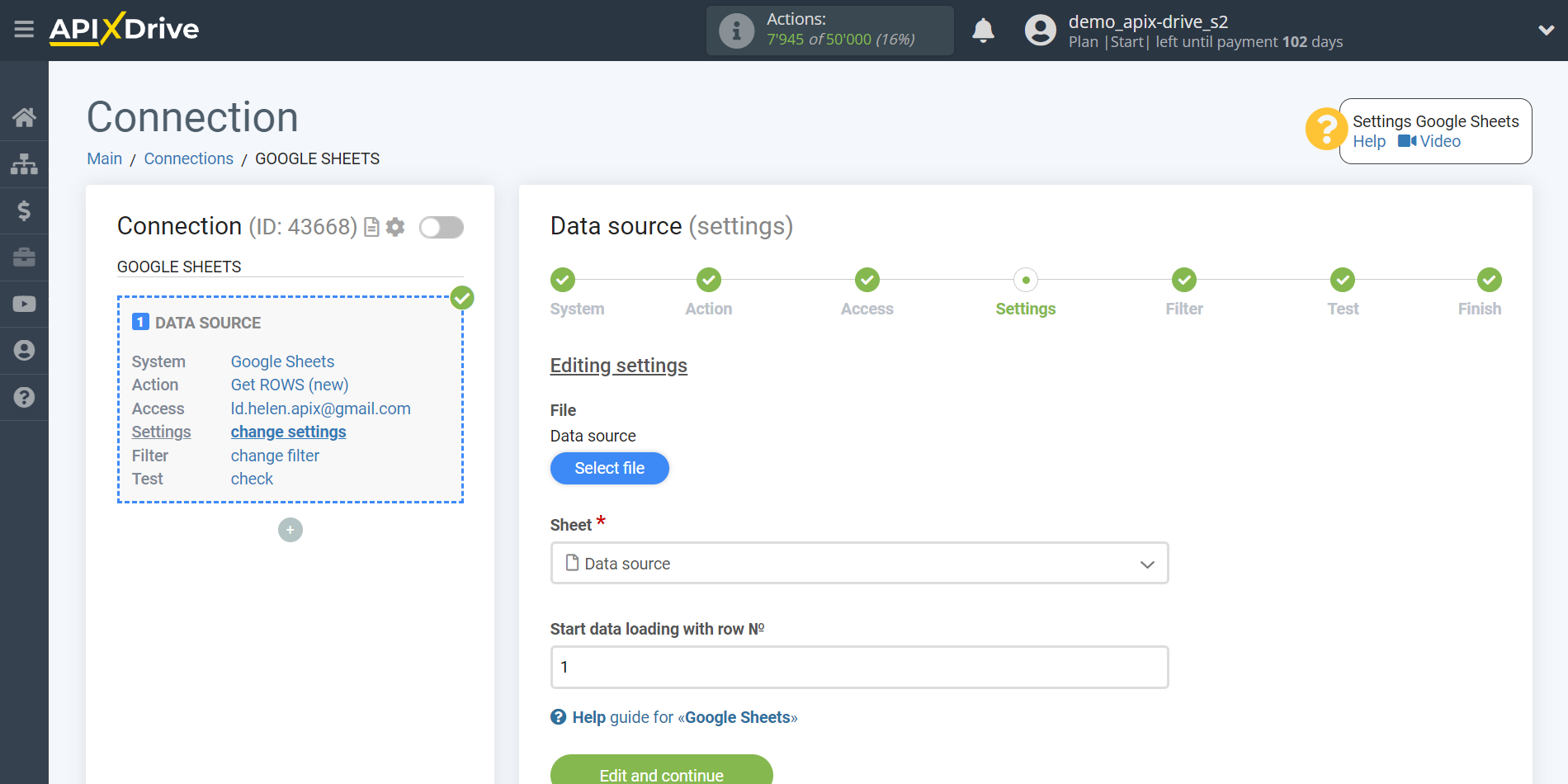
If necessary, you can set up a Data Filter, or click "Continue" to skip this step.
To find out how to setup the Data Filter, follow the link: https://apix-drive.com/en/help/data-filter
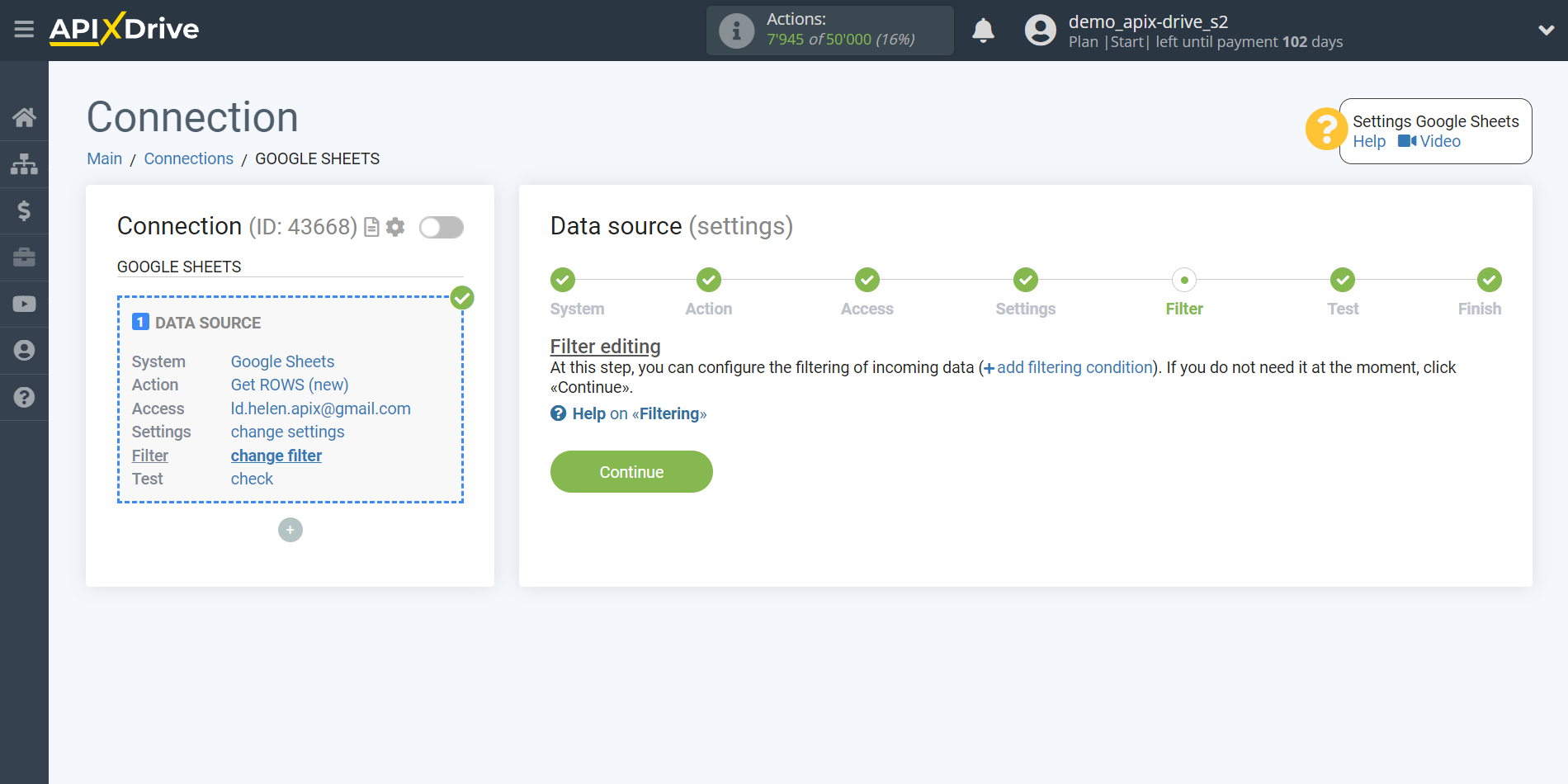
Now you can see the test data for one of the rows in your Google Sheets.
If you want to update the test data - click "Load test data from Google Sheets".
If you want to change the settings - click "Edit" and you will go back one step.
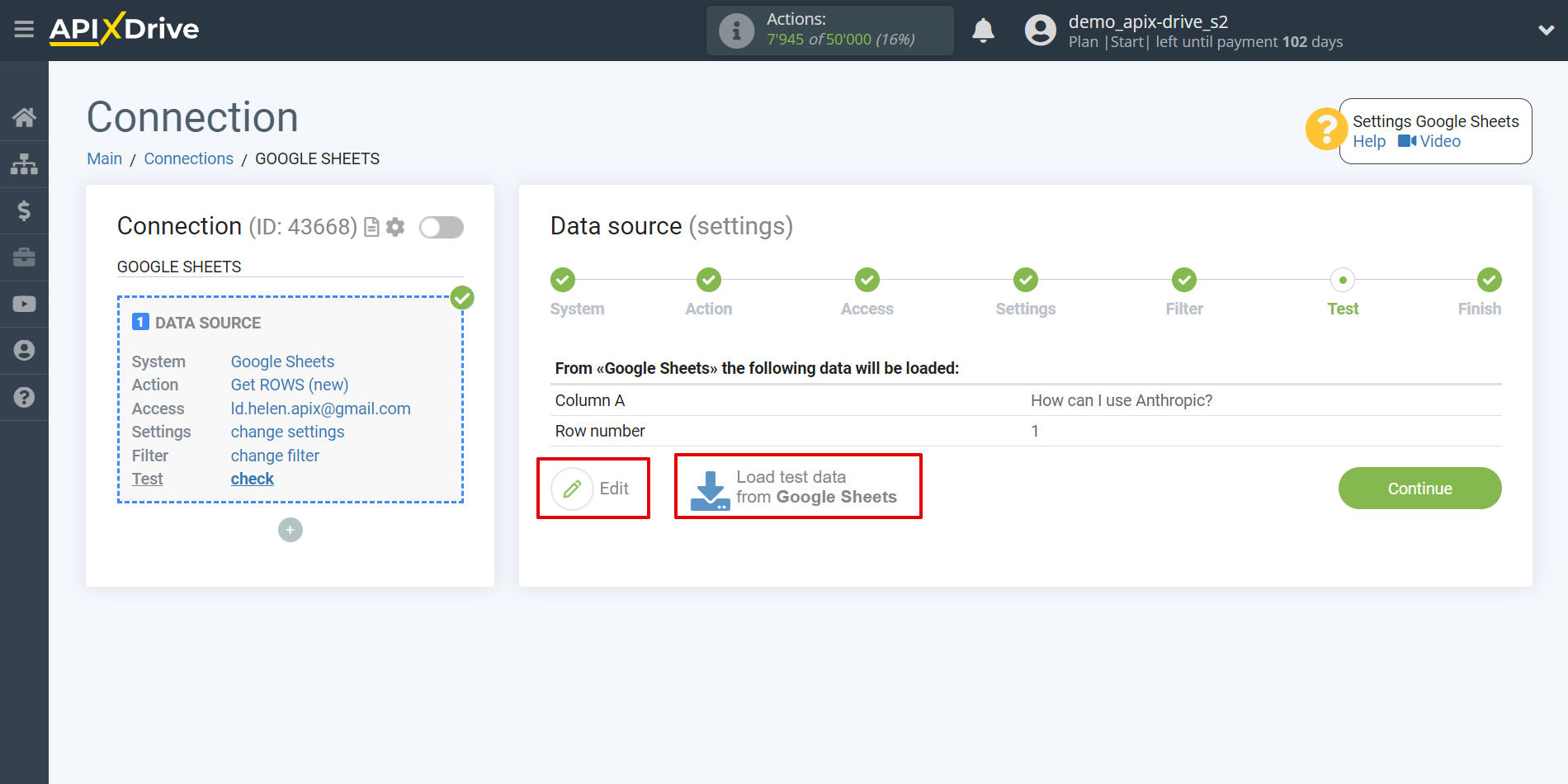
Now we connect the additional OpenAI block (ChatGPT). To do this, click on “+” and select “AI (GPT-Chat)” from the list.

Setting up Anthropic
Select "Anthropic" as the system in which the search will be performed.
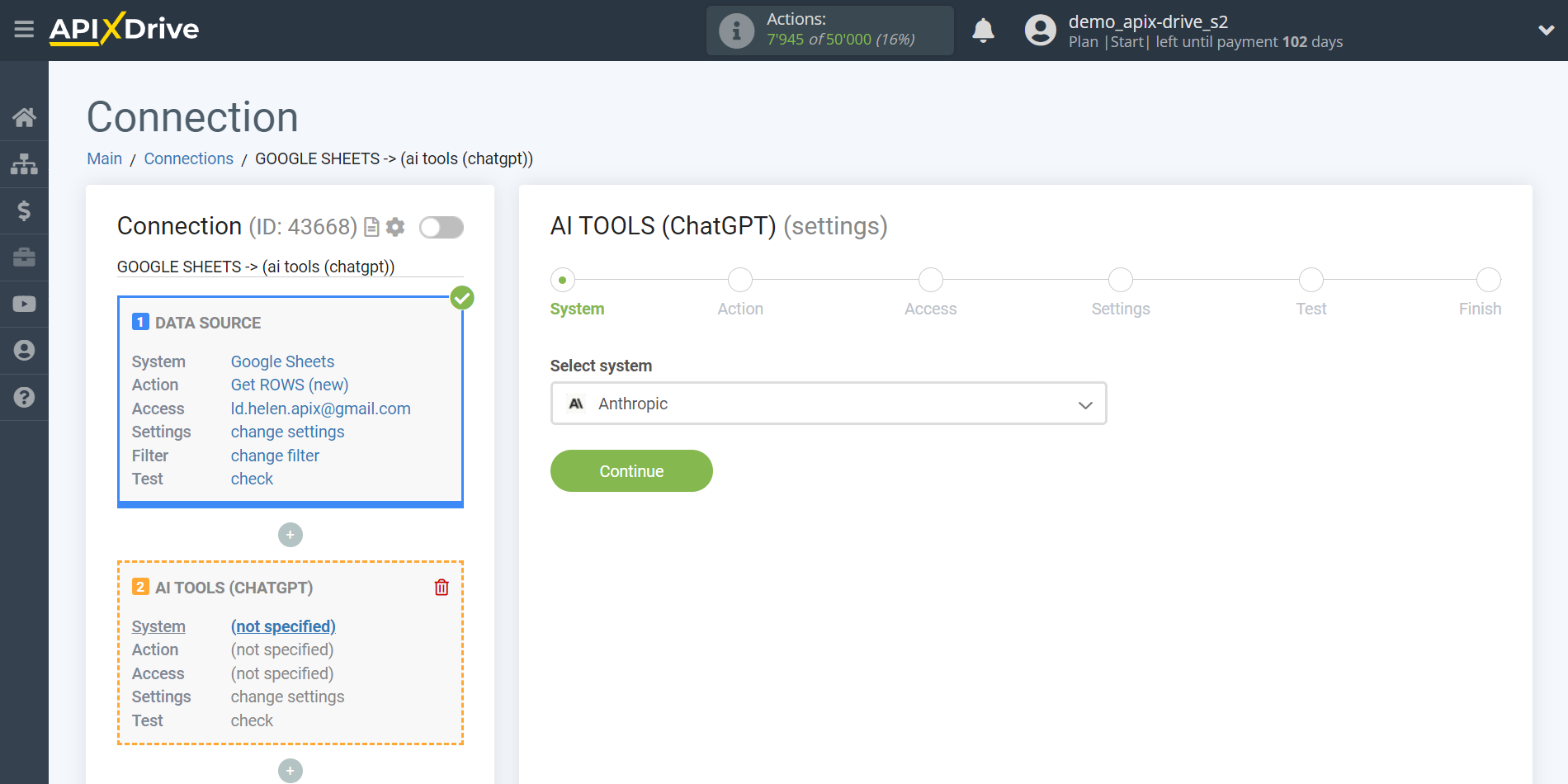
Next, you need to specify the action, for example, "Send PROMPT".

- Send PROMPT - allows you to send a request to Anthropic for gerating, editing and translating data.
The next step is to select an Anthropic account.
If there are no logins connected to the ApiX-Drive system, click “Connect account”.

Enter the API key found in your Anthropic account settings.
Go to your Anthropic account, click on the "API keys" tab in the upper right corner, then click on "Create API key" and enter a name for your key. Copy the API key and paste it into the appropriate field of the account connection window in the ApiX-Drive system.
Click "Save and select the connected Anthropic account from the drop-down list.
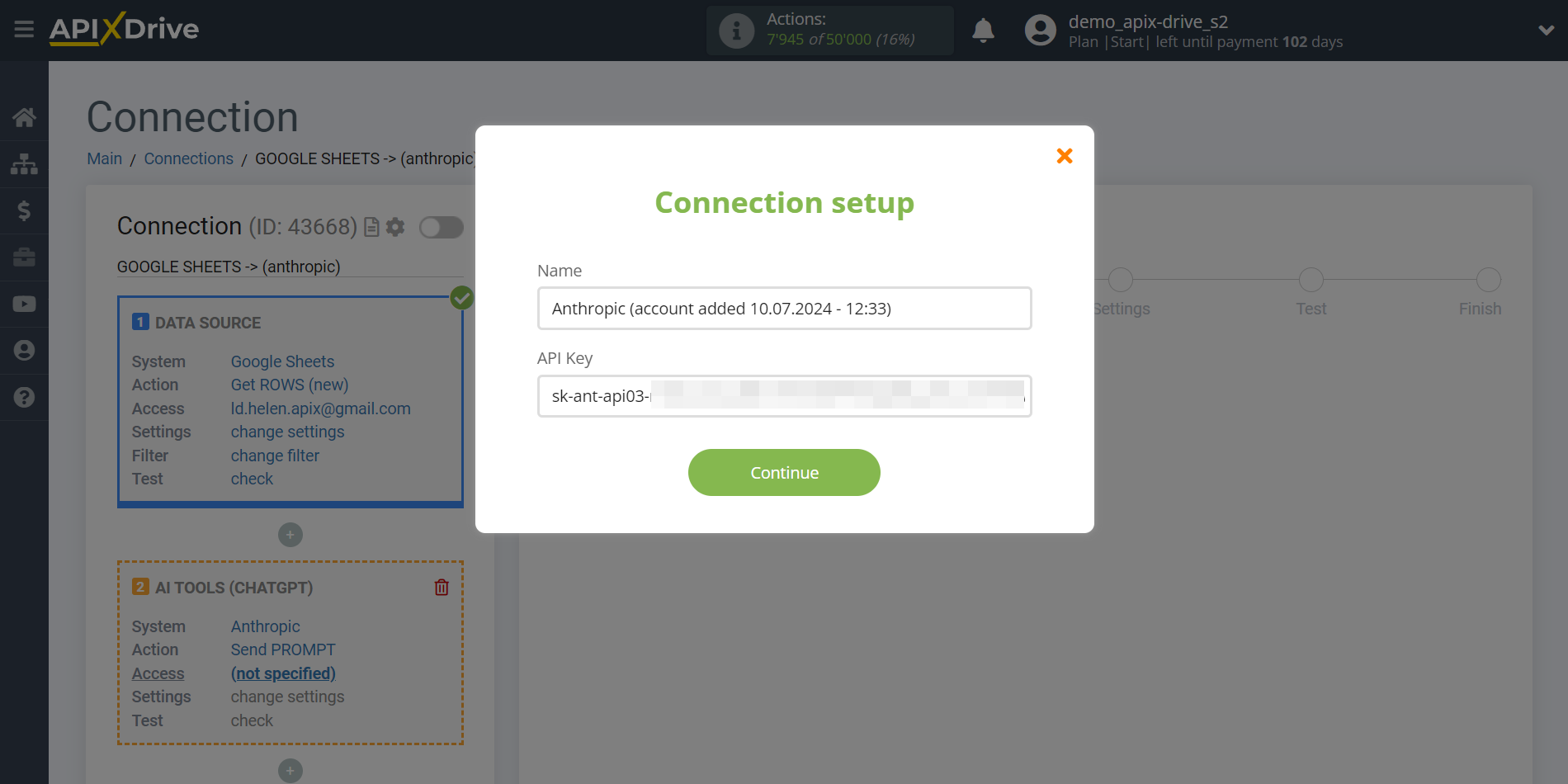


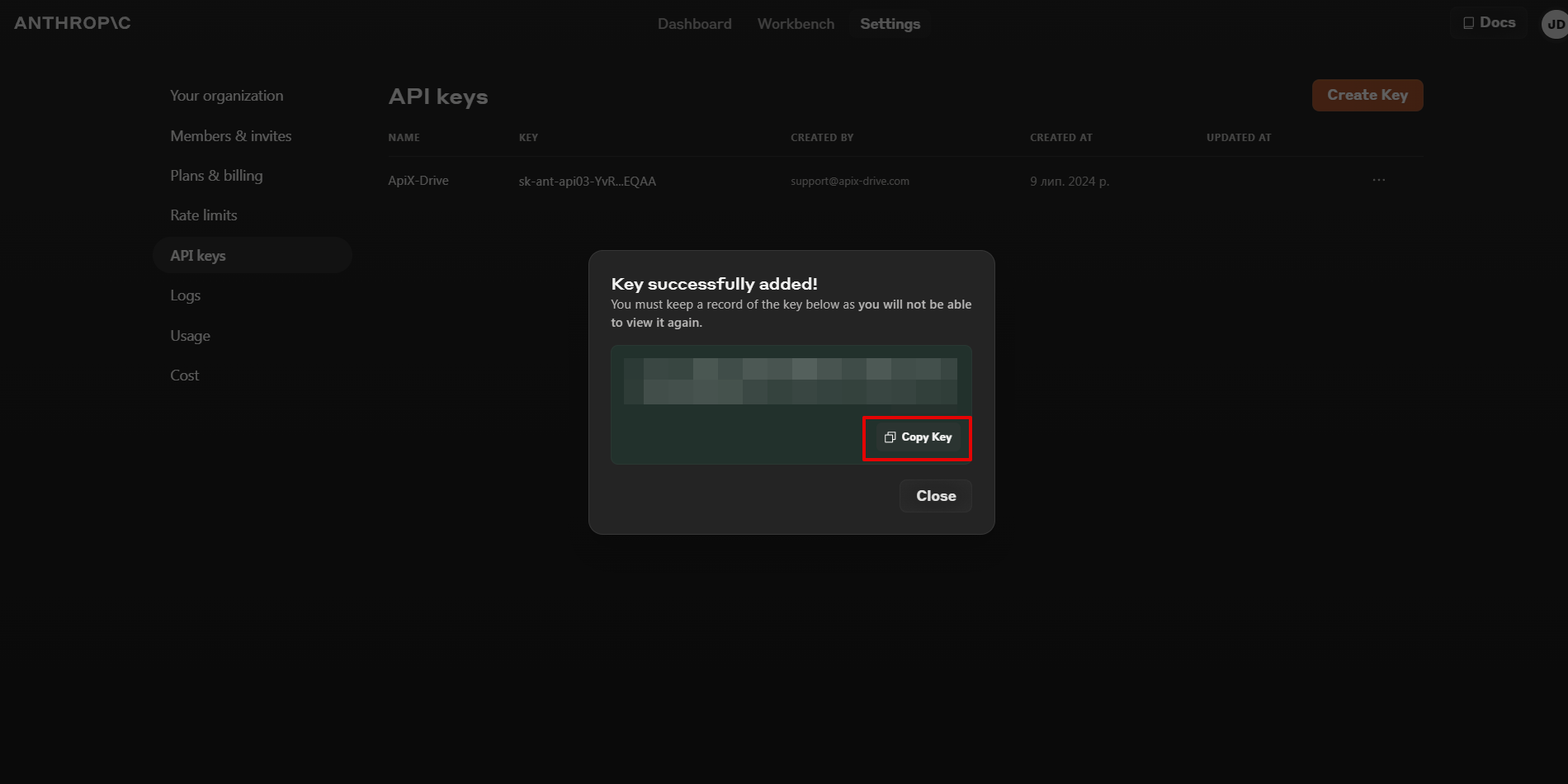
When the connected account appears in the "active accounts" list, select it for further work.
Attention! If your account is on the "inactive accounts" list, check your access to this login!

Now you need to select the Anthropic Model. The choice of model depends on your application.

Claude 3.7 Sonnet - is an advanced AI model from Anthropic, introduced in 2024. It has an outstanding ability to understand and generate text, reason and follow instructions. The model shows significant improvements in accuracy, solving complex tasks and handling long texts compared to previous versions. Claude 3.7 Sonnet is designed with safety and ethical principles in mind, maintaining a balance between utility and responsible use of AI.
Claude 3.5 Sonnet (New) - Anthropic's latest artificial intelligence model, representing a significant advancement in the Claude lineup. This model has improved reasoning, contextual understanding and information processing abilities over previous versions. The Claude 3.5 Sonnet demonstrates increased accuracy in complex tasks including mathematical calculations, data analysis and logical reasoning. The model is designed with safety and responsible use of AI as a priority for Anthropic.
Claude 3.5 Haiku - the most compact and fastest model in Anthropic's Claude 3.5 range. The model is optimized for efficient operation while maintaining high intelligence. Haiku is characterized by lightning-fast response speed, cost-efficiency and the ability to perform complex tasks including context processing, language understanding and quality content creation. It is ideal for scenarios that require a balance between performance and efficiency.
Claude 3.5 Sonnet (Old) - has the high level of intelligence and capability. Training based on April 2024 data.
Claude 3 Opus - high level of intelligence, capability and understanding. A reasonably fast model. Data-driven training August 2023.
Claude 3 Sonnet - has a balance of speed and level of intelligence. Data-driven learning August 2023.
Claude 3 Haiku - is the fastest and most compact model, providing almost instant registration. It is also the cheapest model. Data-driven training August 2023.
Claude 2.1 Sonnet - an improved version of the language model from Anthropic with a context window of 200K tokens. Features high accuracy in processing complex instructions, improved math ability, and advanced reasoning skills. The model shows impressive performance in data analysis, programming, and creative tasks while maintaining high standards of security and reliability.
Claude 2.0 Sonnet - is an enhanced version of Anthropic's language model, characterized by compactness and efficiency. The model combines the advanced capabilities of Claude 2.0 with an optimized architecture that provides faster and more cost-effective responses. Sonnet retains complex reasoning and contextual understanding abilities, but operates in a more compact format, making it ideal for everyday tasks that require a balance between quality and speed of information processing.
Answering Anthropic knowledge base questions and generating text
In this case, select "Claude 3.5 Sonnet".


- Prompt - in this field you need to assign which variable of the Data Source table contains the data for which the query will be made on the Anthropic server, in our case, this is column “A”.
- Presence penalty - This parameter is used to encourage the model to include a variety of tokens in the generated text. This is the value that is subtracted from the log likelihood of the token each time it is generated. A higher Presence Penalty value will cause the model to be more likely to generate tokens that were not already included in the generated text.
- Temperature - can range from 0 to 2. Higher values such as 0.8 will make the output more random, while lower values such as 0.2 will make it more focused and deterministic.
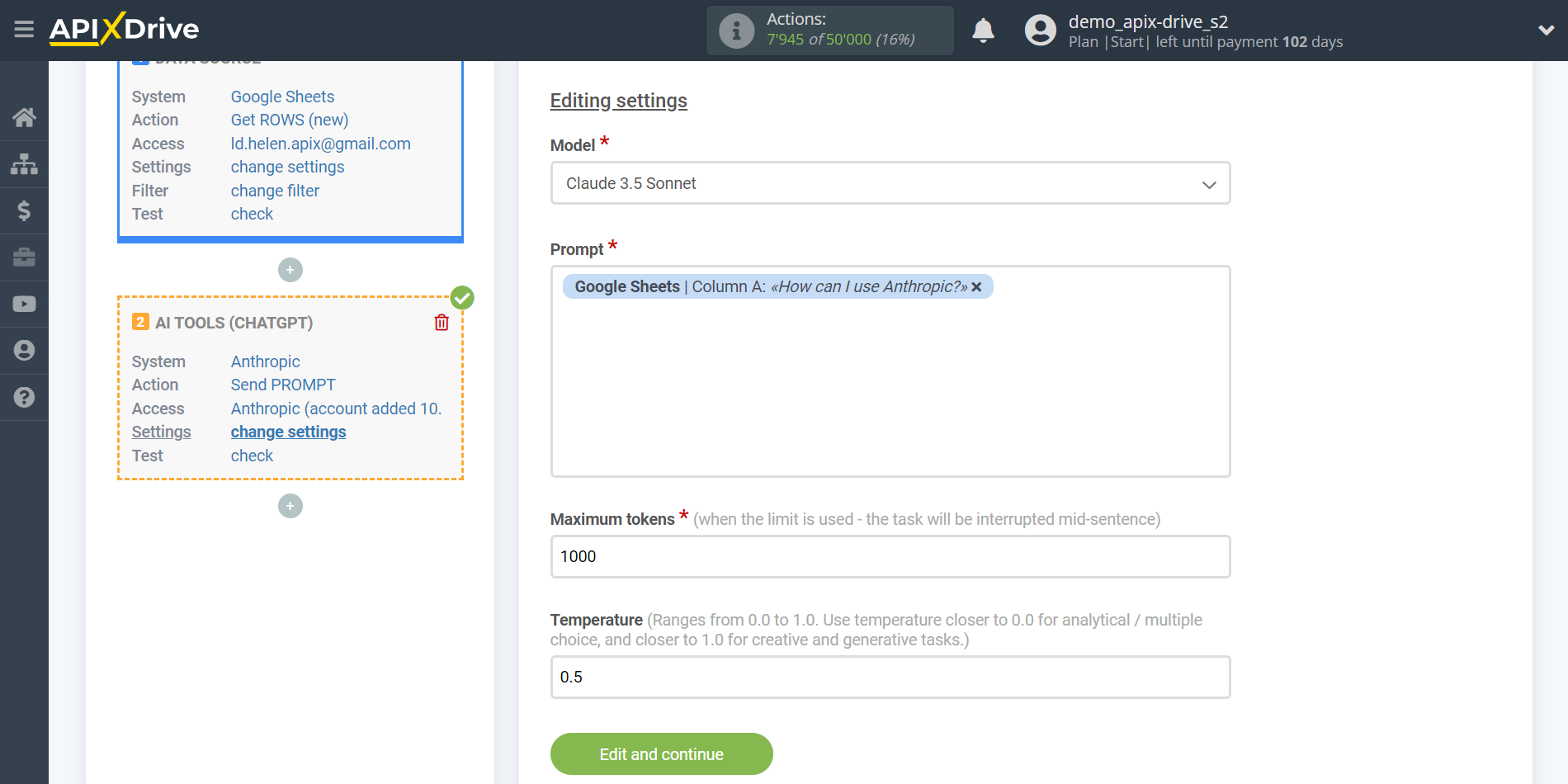
Now you see test data for your request. You can pass this data to your reception table.
If test data does not appear automatically, click "Search in Anthropic".
If you are not satisfied with something, click “Edit”, go back a step and change the search field settings.
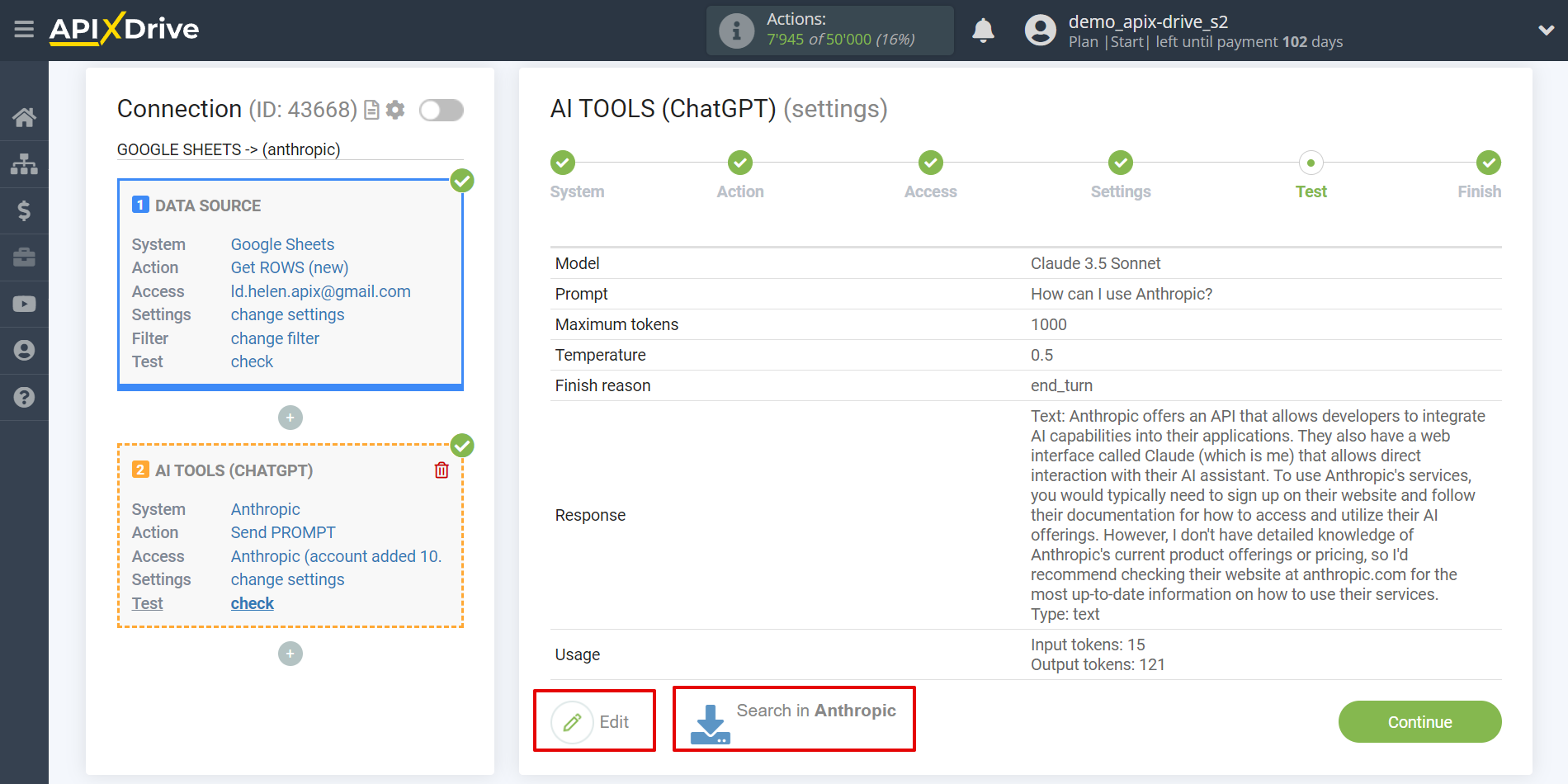
Generation and editing of text according to the request
In this case, select "Claude 3 Opus".

- Prompt - in this field you need to assign which variable of the Data Source table contains the data for which the query will be made on the Anthropic server, in our case, this is column “A”.
- Presence penalty - This parameter is used to encourage the model to include a variety of tokens in the generated text. This is the value that is subtracted from the log likelihood of the token each time it is generated. A higher Presence Penalty value will cause the model to be more likely to generate tokens that were not already included in the generated text.
- Temperature - can range from 0 to 2. Higher values such as 0.8 will make the output more random, while lower values such as 0.2 will make it more focused and deterministic.
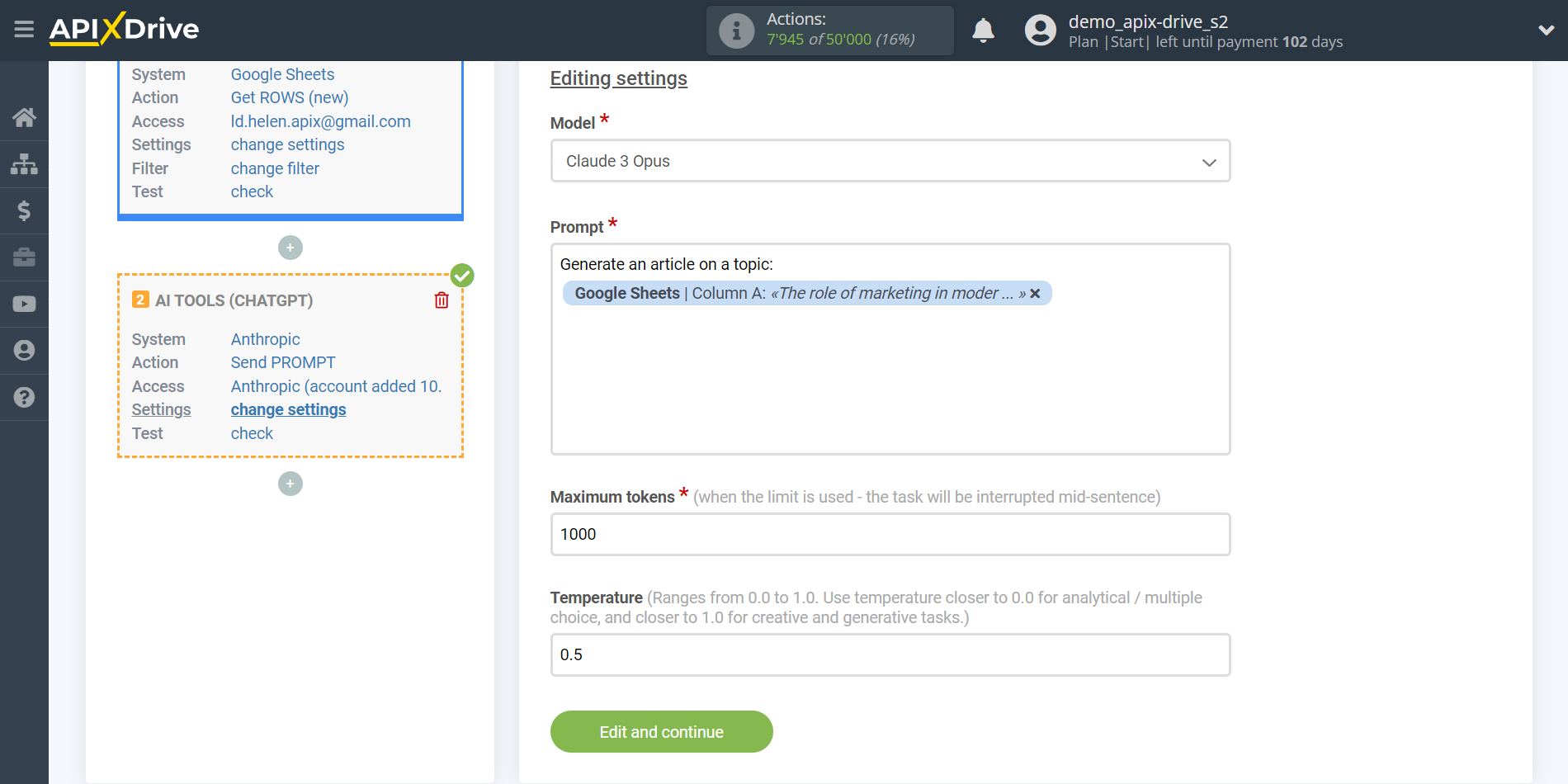
Now you see test data for your request. You can pass this data to your reception table.
If test data does not appear automatically, click "Search in Anthropic".
If you are not satisfied with something, click “Edit”, go back a step and change the search field settings.
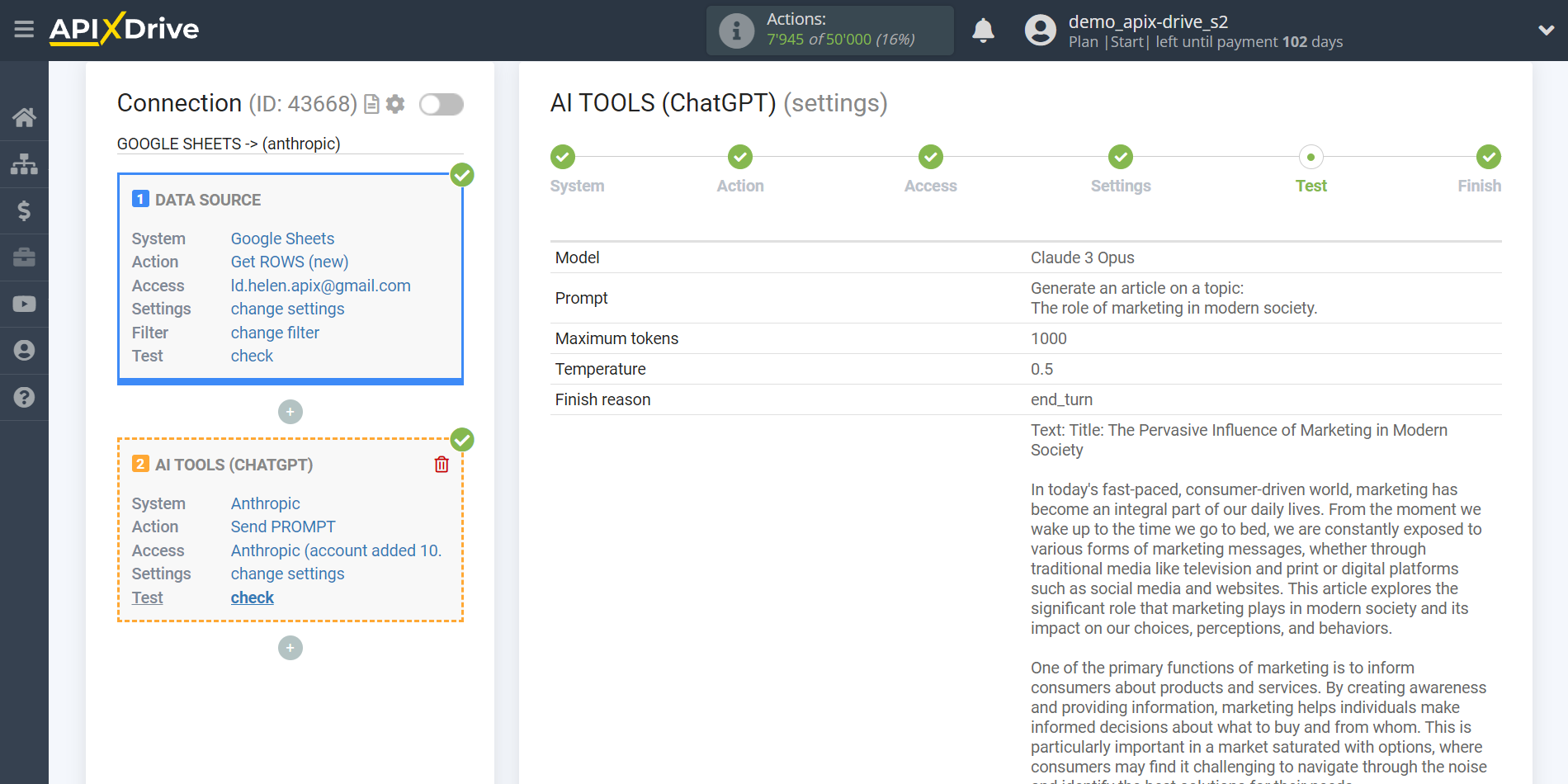
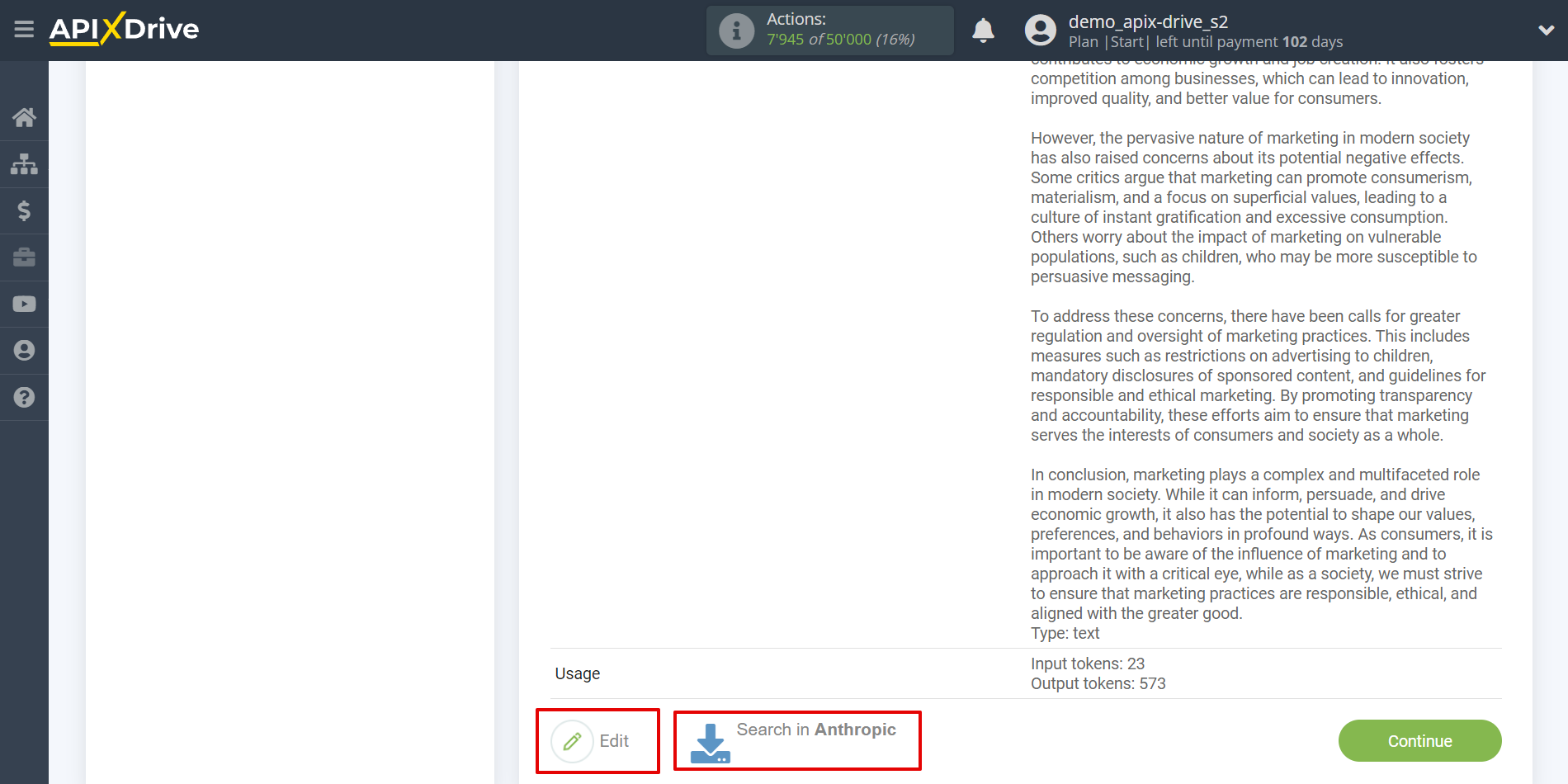
Mathematical calculations and modelling
In this case, select "Claude 3 Sonnet".

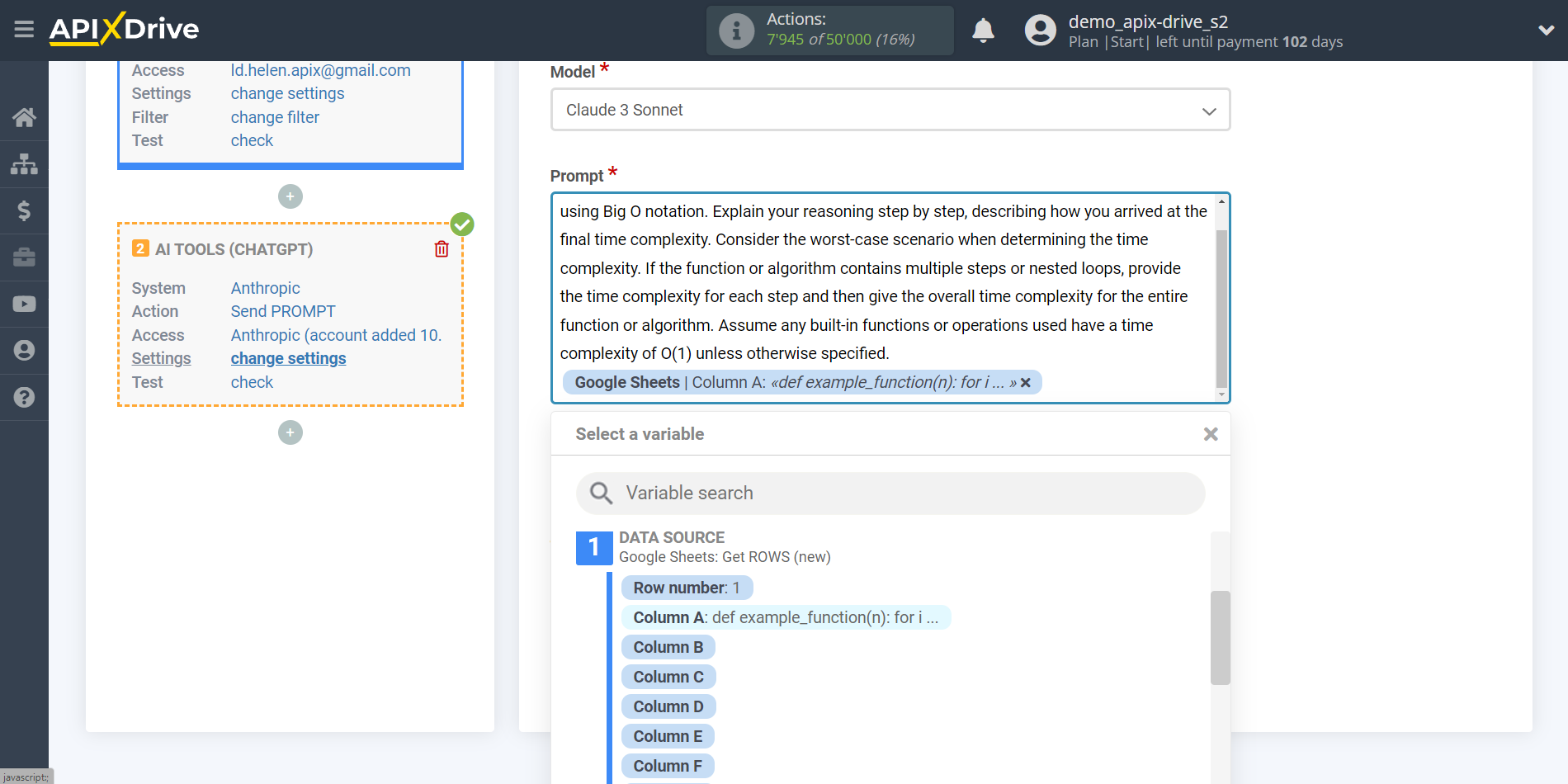
- Prompt - in this field you need to assign which variable of the Data Source table contains the data for which the query will be made on the Anthropic server, in our case, this is column “A”.
- Presence penalty - This parameter is used to encourage the model to include a variety of tokens in the generated text. This is the value that is subtracted from the log likelihood of the token each time it is generated. A higher Presence Penalty value will cause the model to be more likely to generate tokens that were not already included in the generated text.
- Temperature - can range from 0 to 2. Higher values such as 0.8 will make the output more random, while lower values such as 0.2 will make it more focused and deterministic.
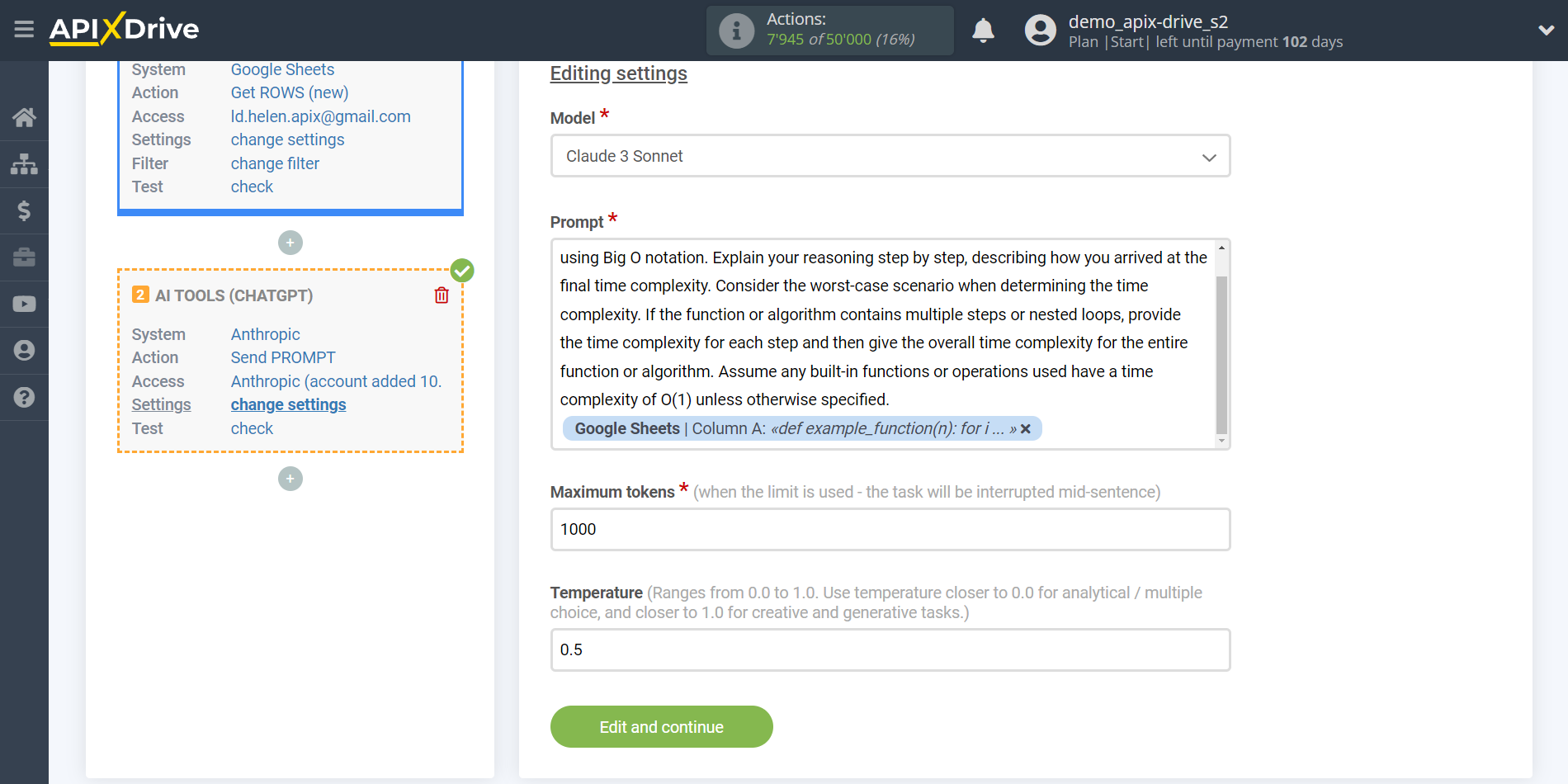
Now you see test data for your request. You can pass this data to your reception table.
If test data does not appear automatically, click "Search in Anthropic".
If you are not satisfied with something, click “Edit”, go back a step and change the search field settings.

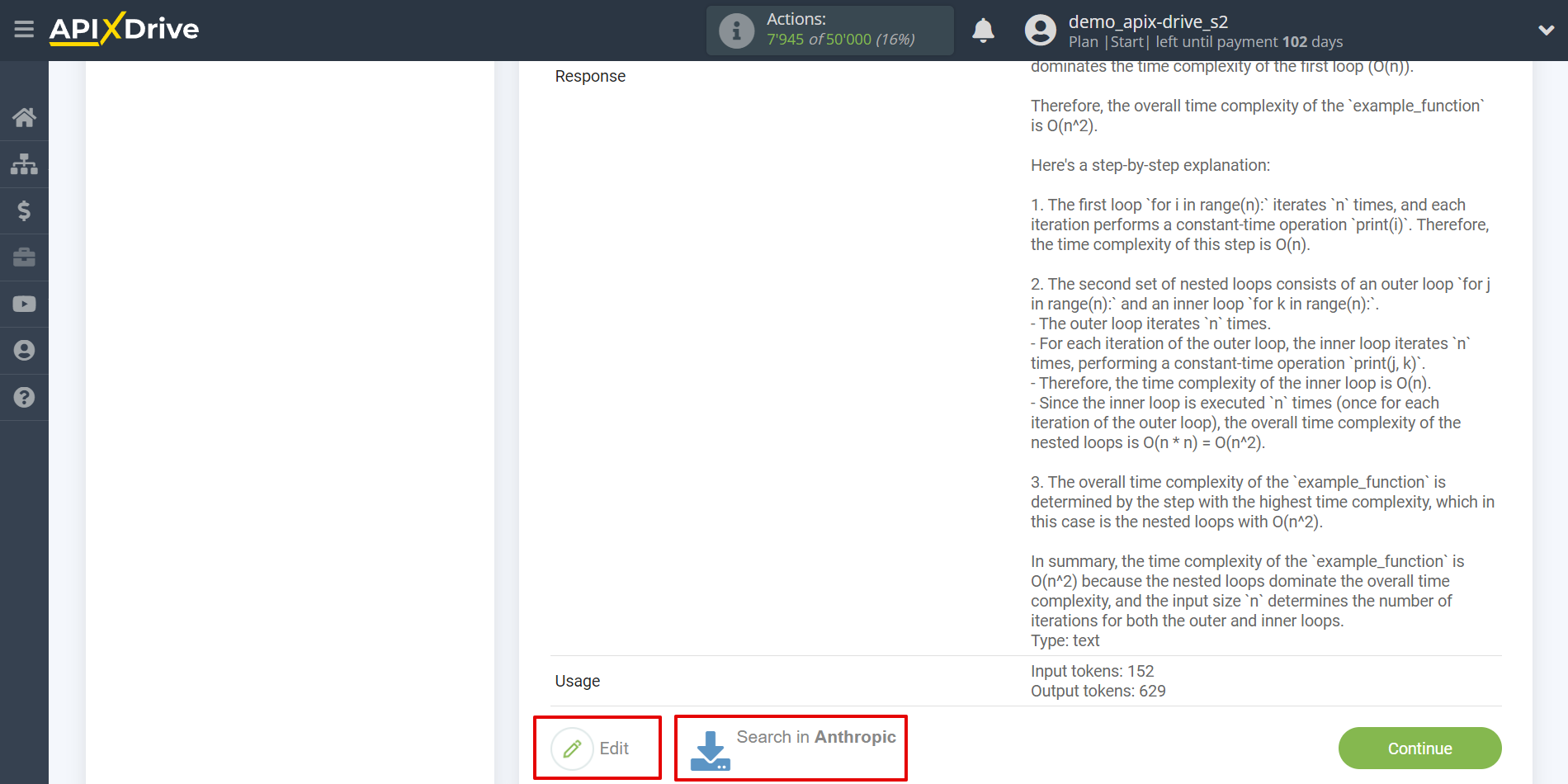
Data analysis and structuring
In this case, select "Claude 3 Haiku".

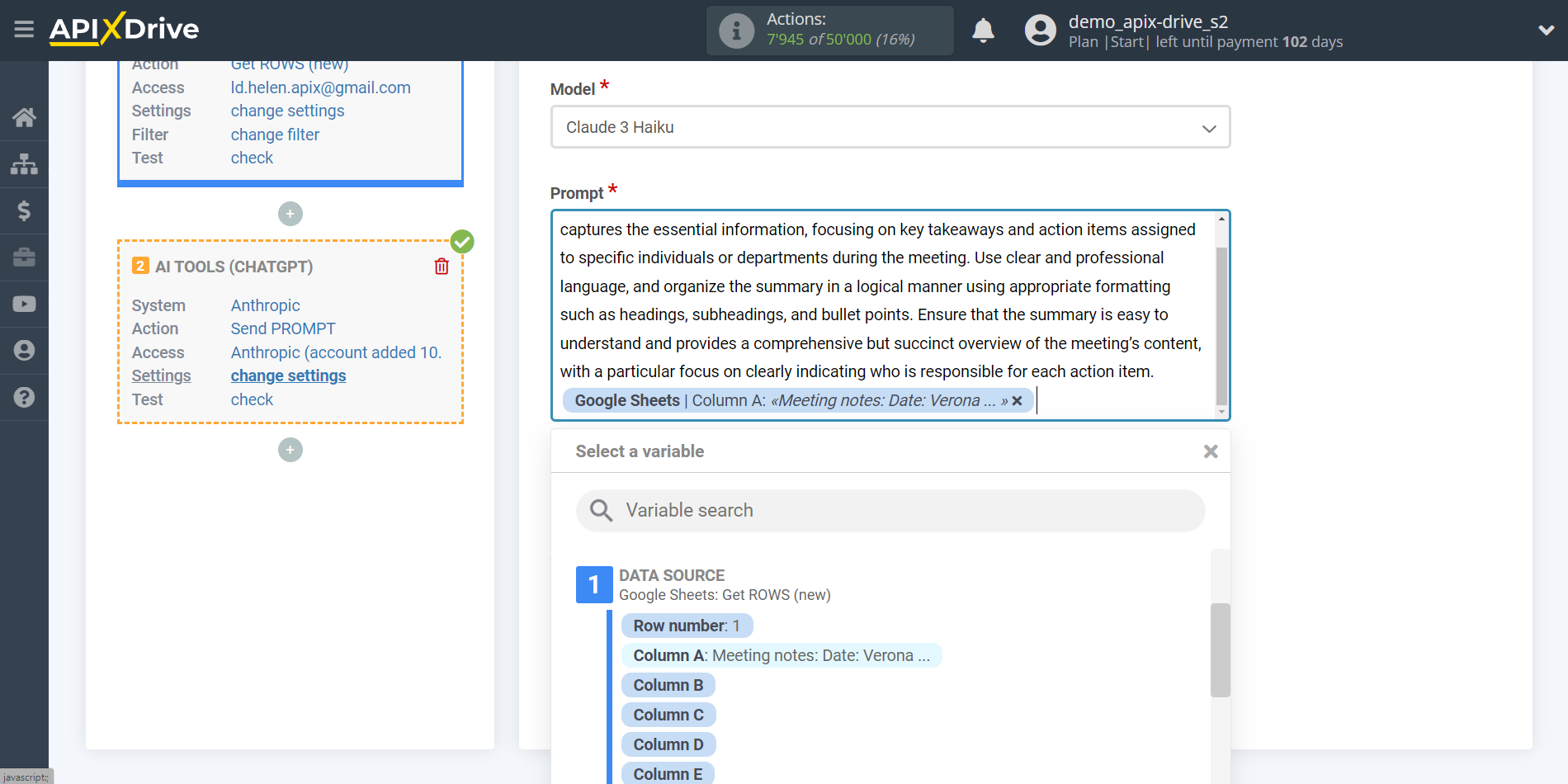
- Prompt - in this field you need to assign which variable of the Data Source table contains the data for which the query will be made on the Anthropic server, in our case, this is column “A”.
- Presence penalty - This parameter is used to encourage the model to include a variety of tokens in the generated text. This is the value that is subtracted from the log likelihood of the token each time it is generated. A higher Presence Penalty value will cause the model to be more likely to generate tokens that were not already included in the generated text.
- Temperature - can range from 0 to 2. Higher values such as 0.8 will make the output more random, while lower values such as 0.2 will make it more focused and deterministic.

Now you see test data for your request. You can pass this data to your reception table.
If test data does not appear automatically, click "Search in Anthropic".
If you are not satisfied with something, click “Edit”, go back a step and change the search field settings.
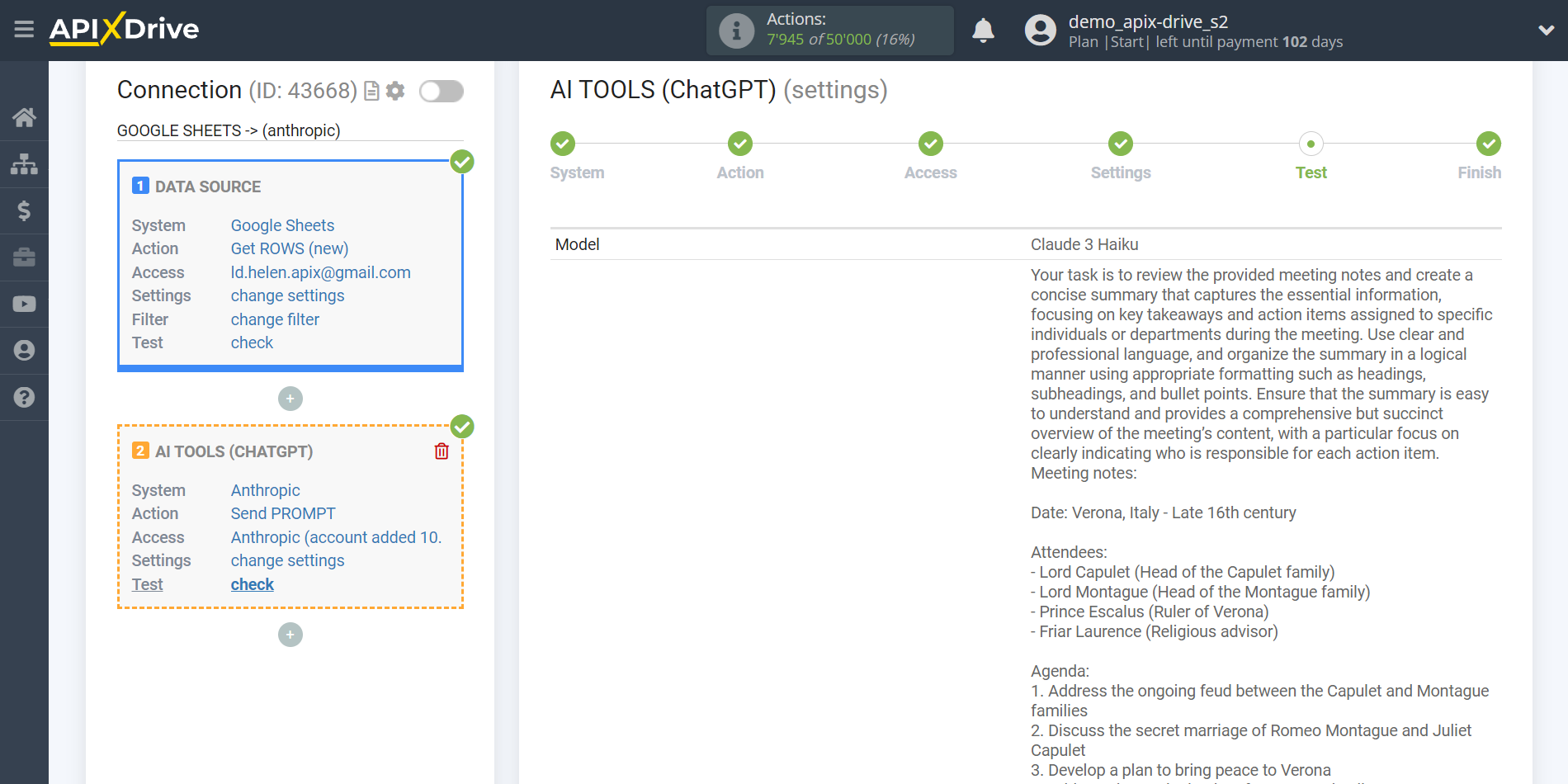
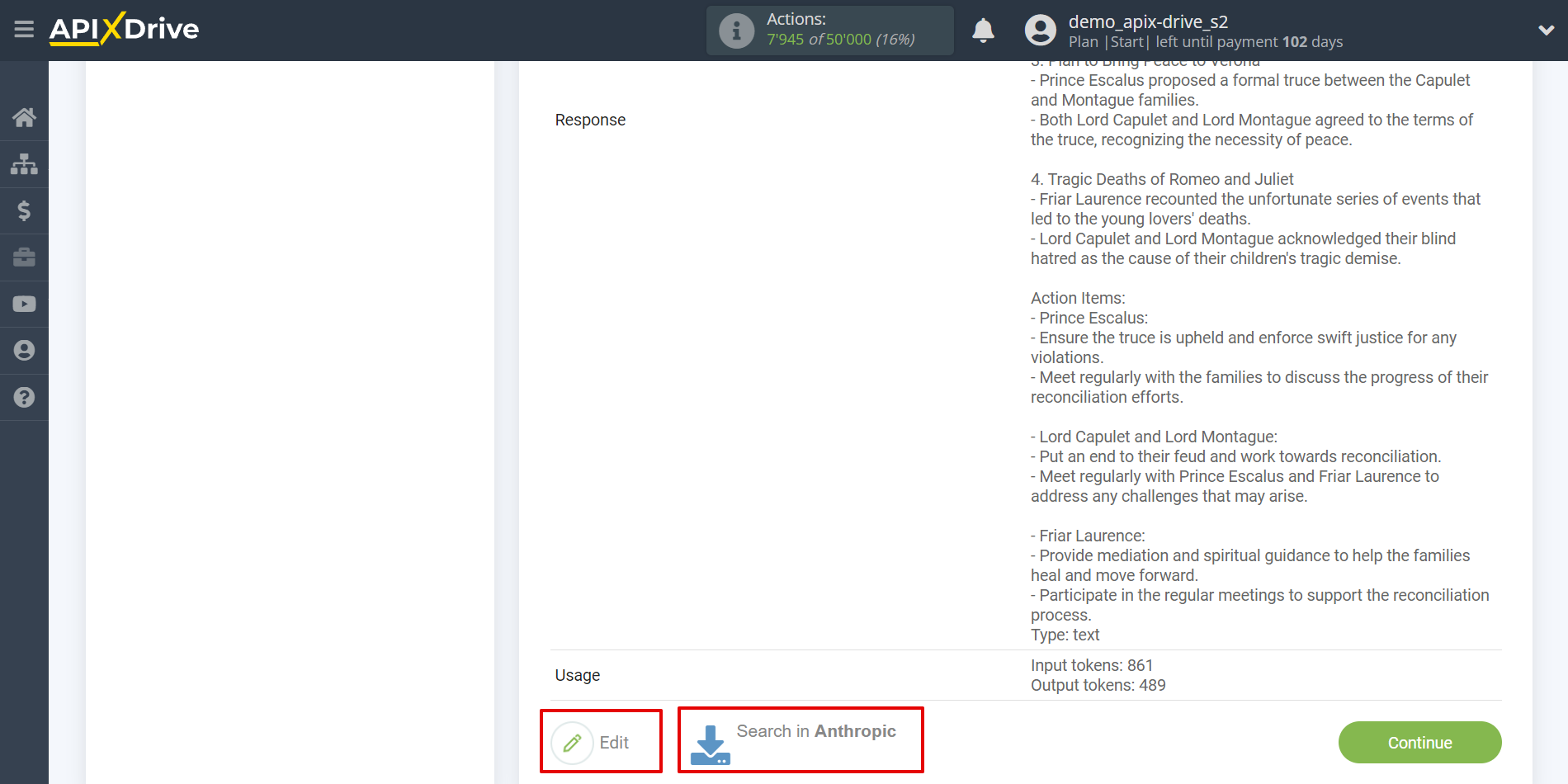
This completes the configuration of Anthropic data!
Now we can start setting up Google Sheets as a Data Receiver system.
To do this, click "Add Data Destination".

Setup Data Destination system: Google Sheets
Select the system as Data Destination. In this case, you must specify Google Sheets.
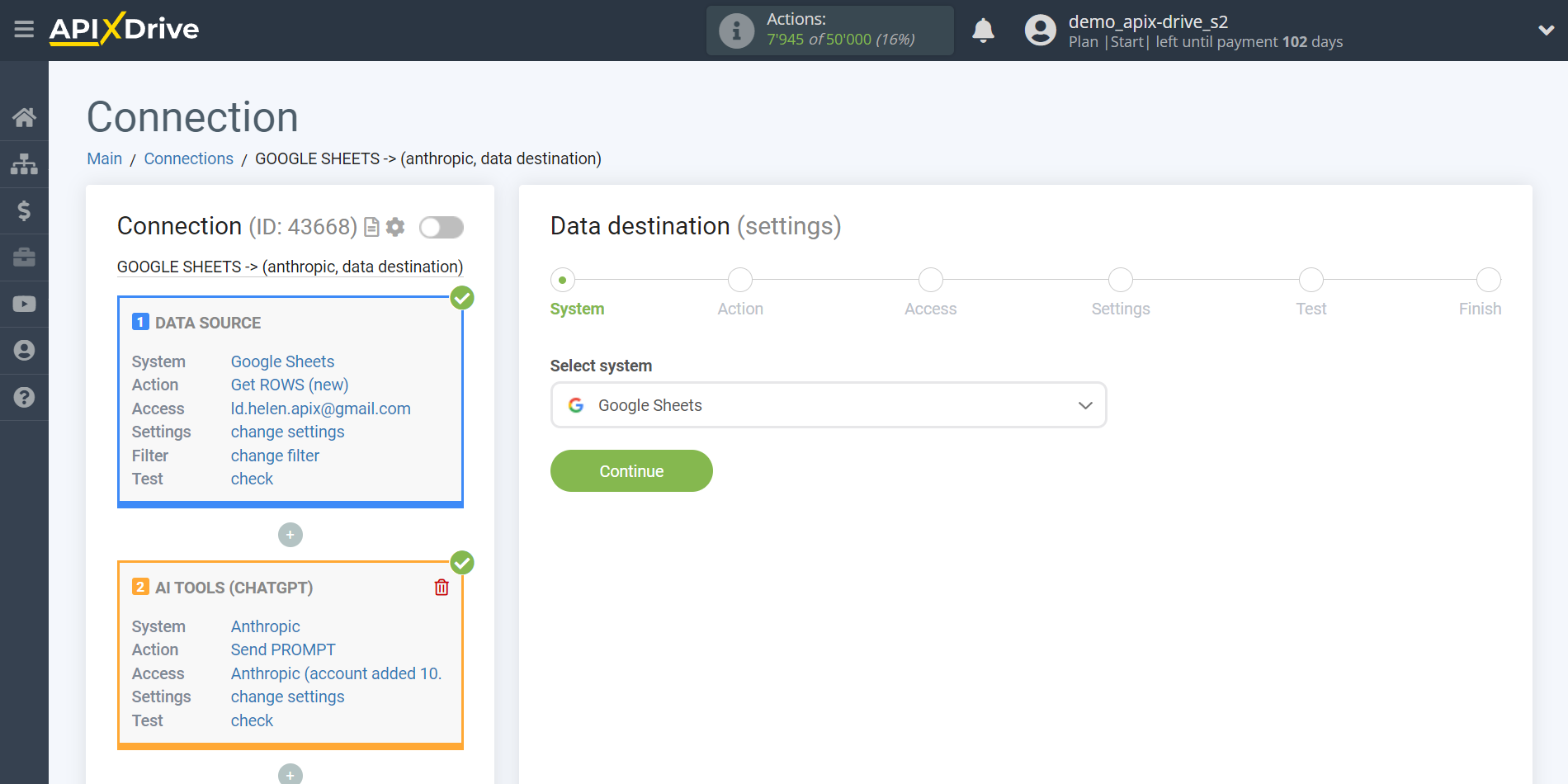
Next, you need to specify the action "Update ROW".
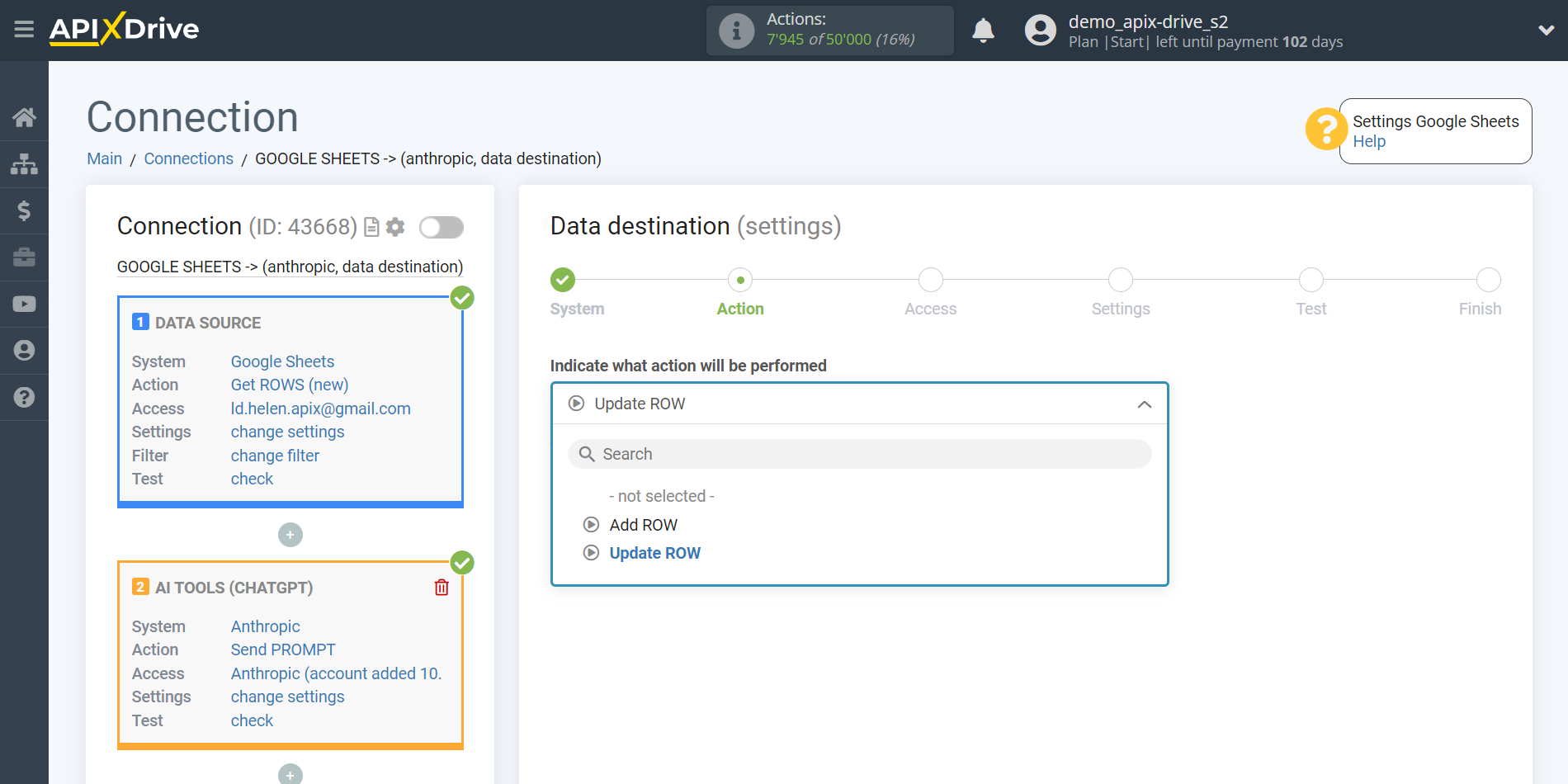
The next step is to select a Google Sheets account into which the result of the Anthropic request will be transferred. If this is the same account, then we select it.
If you need to connect another login to the system, click “Connect account” and repeat the same steps described when connecting Google Sheets as a Data Source.

Now you need to select the File (Table) and Sheet in which the status of Anthropic will be updated.
In the "Search column" field, you need to select the column by which the data will be searched. That is, where to look for data in the table.
Next, in the "Search" field, you need to select a variable from the drop-down list or enter the data manually, by which value the system will search for data to update the row you need. In our case, we select column "A", which contains the data about the request. The system will update the data in the desired row only if it matches the requested data.
Also, you need to specify the Search Type, in case several rows with the same query are found:
"Take the first found row" - searching and updating data will occur in the first found row that satisfies the search conditions.
"Take the last found row" - searching and updating data will occur in the last found row that satisfies the search conditions.
"Take all found rows" - search and update of data will be performed on all found rows that satisfy the search conditions.
Now you need to assign a variable with the result of the query, which we take from the Data Search block, to the empty column. In the future, this column will be updated according to your request.
After setting, click "Continue".

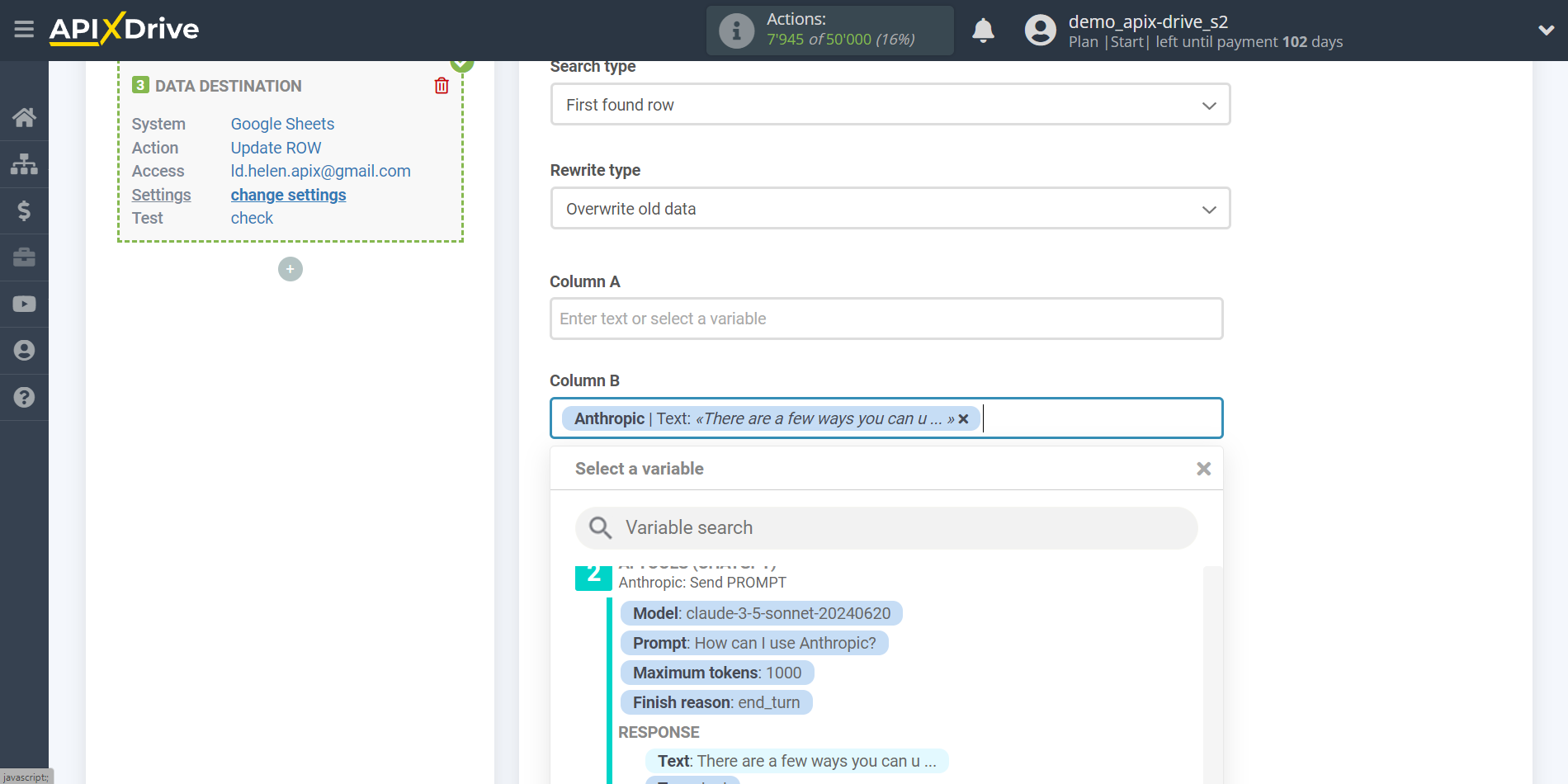
Thus, the Anthropic block takes the field in the Data Source in which you have written the request text, queries the OpenAI server (ChatGPT) for the result of this request and transfers this data to the Data Reception field, for example, in column “B”.

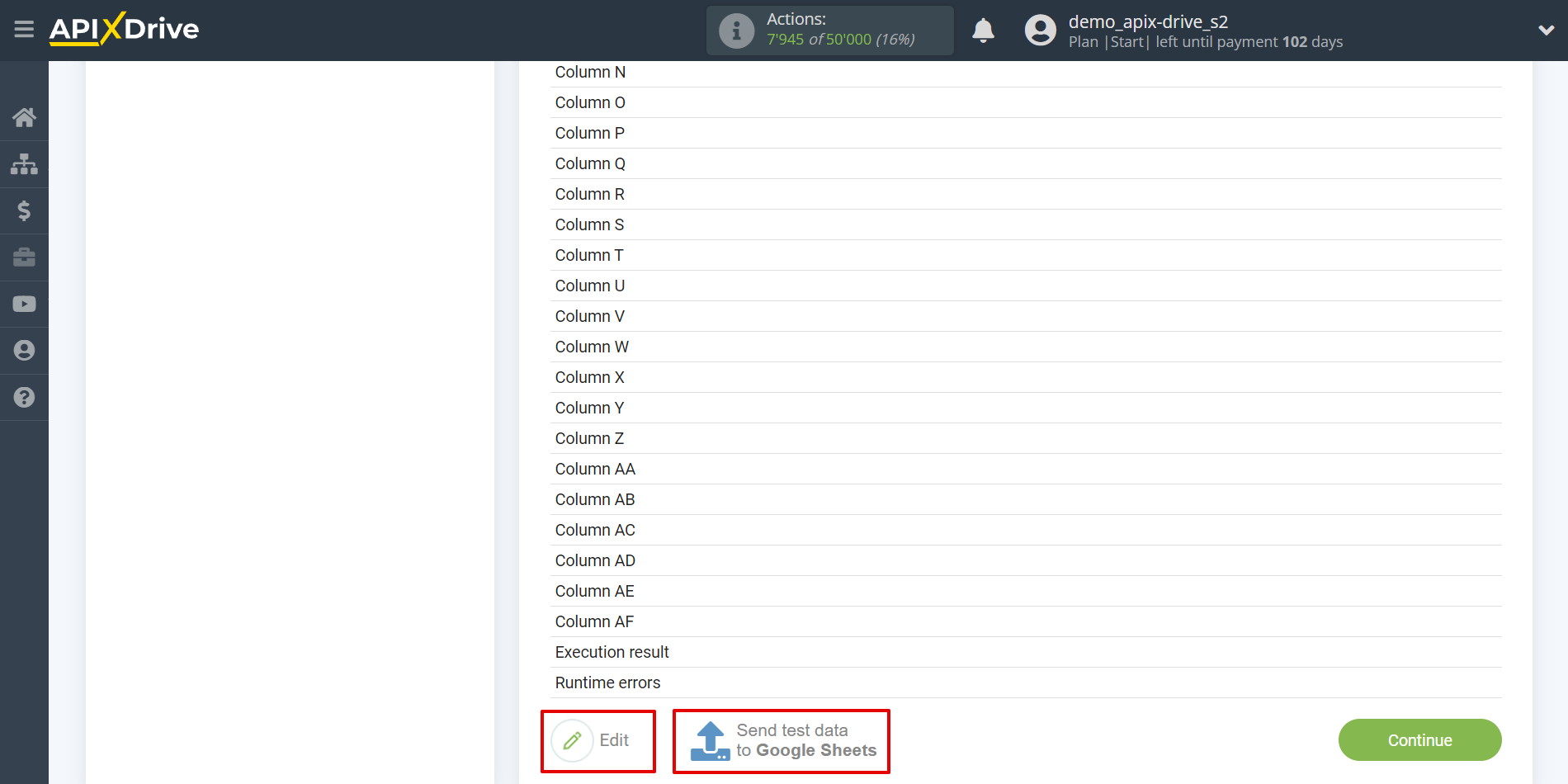
This completes the Data Destination system setup!
Now you can start choosing the update interval and enabling auto-update.
To do this, click "Enable update".
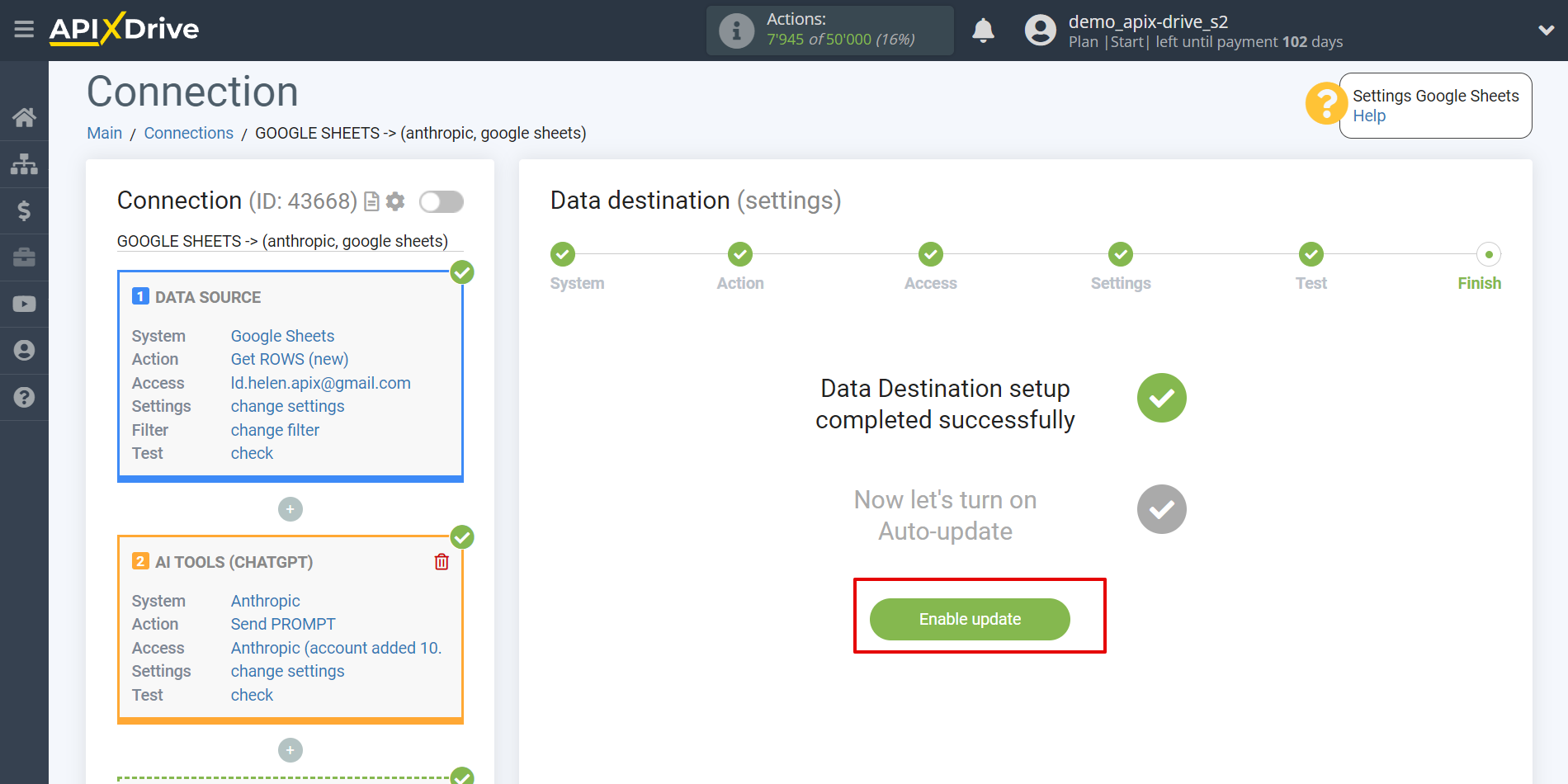
On the main screen, click on the gear icon to select the required update interval or set up scheduled launch. To start the connection by time, select scheduled start and specify the desired time for the connection update to fire, or add several options at once when you need the connection to fire.
Attention! In order for the scheduled run to work at the specified time, the interval between the current time and the specified time must be more than 5 minutes. For example, you select the time 12:10 and the current time is 12:08 - in this case, the automatic update of the connection will occur at 12:10 the next day. If you select the time 12:20 and the current time is 12:13 - the auto-update of the connection will work today and then every day at 12:20.
To make the current connection transmit data only after another connection, check the box "Update connection only after start other connection" and specify the connection after which the current connection will be started.



This completes the setup of Anthropic! Everything is quite simple!
Now don't worry, ApiX-Drive will do everything on its own!